Most of the companion plants for Bee balm are flowers and plants that are mostly cultivated for ornamental purposes; we also have vegetables that benefit from the interaction of bee balm with pollinators. But before we look into these plants, let us talk about bee balm as a garden plant.
The plant known as Monarda, or bee balm, native to North America, is a perennial herb that belongs to the mint family. Its size can range from 2 to 4 feet tall with a spread of 1 to 3 feet. Bee balm is known for its erect and bushy growth habit, square stems, and pairs of lance-shaped leaves, which emit a pleasing aroma when crushed. The plant produces brightly colored blooms in shades of red, pink, purple, and white, arranged in clusters at the top of the stem, attracting pollinators such as bees, butterflies, and hummingbirds.
Besides being an excellent ornamental plant, bee balm also has culinary applications. Both the leaves and the blooms are edible, offering a minty flavor that can be used to brew tea or added to salads, soups, and stews. The blooms have a milder flavor and are commonly used as a garnish or to add flavor and color to fruit salads.
It’s essential to note that only the edible parts of the bee balm plant should be used when collecting for consumption. The blooms and leaves are edible, but the stems and roots are not. Flowers should be plucked when they have fully bloomed, and leaves can be gathered throughout the growing season.
Bee balm comes in a variety of red and pink hues, with some types featuring purple or white blossoms. The blooms are aesthetically fascinating due to their peculiar tubular form and two-lipped structure. It’s a versatile plant that can be utilized in a variety of ways in the home garden. It can serve as a border plant, a mixed border plant, or a specimen plant. Bee balm thrives in wildflower meadows and attracts a wide variety of useful insects. It is also used in herbal medicine to treat a variety of disorders, such as colds, flu, and digestive problems.
Bee balm requires well-drained soil and grows in full sun to light shade. Although it is a low-maintenance, easy-to-grow plant, it is sensitive to a few diseases and pests, including powdery mildew, spider mites, and aphids. Adequate air circulation around the plants and base watering can help prevent these problems.
When planted in conjunction with other plants, bee balm can give a variety of benefits. It attracts helpful insects such as pollinators and predatory insects that help control pests, making it a good companion plant for vegetables such as tomatoes and peppers. Bee balm is also an excellent companion plant for herbs like basil and thyme because it repels pests like aphids and spider mites. Moreover, bee balm can improve soil health by attracting helpful soil bacteria.
In this article, we are going to learn about Forty-four (44) Good companion plants for Bee balm and Four (4) Bad companion plants for Bee balm, also the reason why they should be planted with bee balm or not.
Table of Contents
Good Companion Plants for Bee Balm
1. Anise Hyssop
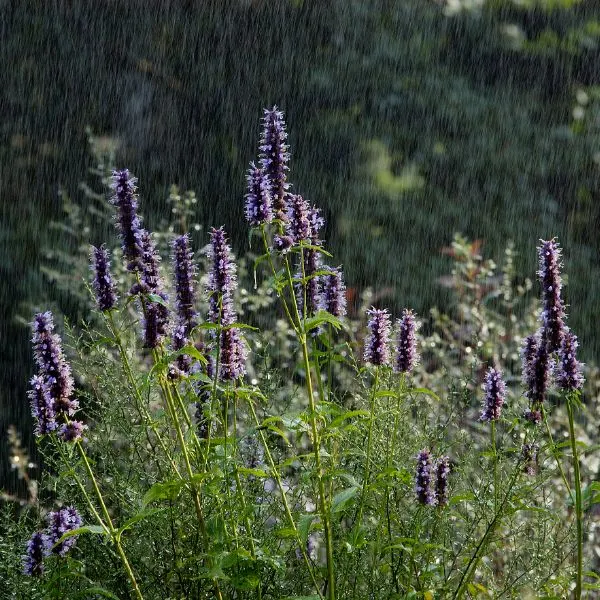
- Botanical name: Agastache foeniculum
- Sun Requirements: Full sun to partial shade, at least 4-6 hours of direct sunlight per day
- Soil Type: Well-drained soil of sand, loam, or clay, with a pH level of 6.0 to 7.5
Anise hyssop, a fascinating flowering herb, belongs to the mint family and is well known for its sweet scent and licorice flavor. This popular plant can be found in various forms, including teas, desserts, and cocktails, making it a sought-after herb. With long spikes of lavender-blue flowers that attract bees and butterflies, anise hyssop is a hardy plant that can grow up to 4 feet tall and blooms from mid-summer to early fall, adding to its appeal.
Hyssop companion plants are a great way to add diversity and beauty to your garden. Bee balm and anise hyssop, two exquisite flowering herbs, are great companions that offer numerous benefits. They both have the ability to attract pollinators like bees and butterflies, which can enhance vegetable yields in neighboring gardens.
Anise hyssop’s strong fragrance can help deter pests such as spider mites and aphids, which can prove beneficial to bee balm. Moreover, anise hyssop’s deep taproot can aid in soil drainage, providing assistance to bee balm, which favors well-drained soil. Anise hyssop is also an excellent companion plant for various crops, including tomatoes, peppers, and brassicas.
Planting bee balm and anise hyssop together can create an aesthetically pleasing garden bed, as both plants have stunning flowers in various colors. The benefits of bee balm and anise hyssop as companions extend beyond aesthetics, as they offer a range of advantages to each other and the ecosystem as a whole. Therefore, they are an excellent addition to any garden.
2. Aster

- Botanical name: Asteraceae
- Sun Requirements: Full sun to partial shade
- Soil Type: Well-drained, fertile soil
Aster is a fascinating perennial plant that belongs to the Asteraceae family. It produces daisy-like flowers in shades of pink, purple, blue, and white and is commonly used as borders or groundcovers in gardens. Typically blooming in the fall, it’s a must-have in any garden.
Aster and bee balm make great companions in the garden. One of the advantages is that their overlapping bloom times can create an extended period of flowering, attracting a greater variety of pollinators and beneficial insects. Additionally, Aster flowers are known to attract natural predators of common garden pests, which can help control pest populations in the garden, benefiting bee balm and other nearby plants. Besides, asters have long taproots that can help break up compacted soil and improve soil structure, aiding the growth and health of bee balm and other plants in the area.
Aster is known to be an excellent companion plant for several crops, including tomatoes, beans, and brassicas. Therefore, planting asters near bee balm can improve the health and yield of nearby plants. The functional benefits of asters and bee balm don’t detract from their aesthetic appeal. These plants add color and texture to the garden, creating a beautiful and visually appealing garden bed. Overall, asters make a valuable addition to the garden when paired with bee balm as a companion plant.
3. Black-Eyed Susan
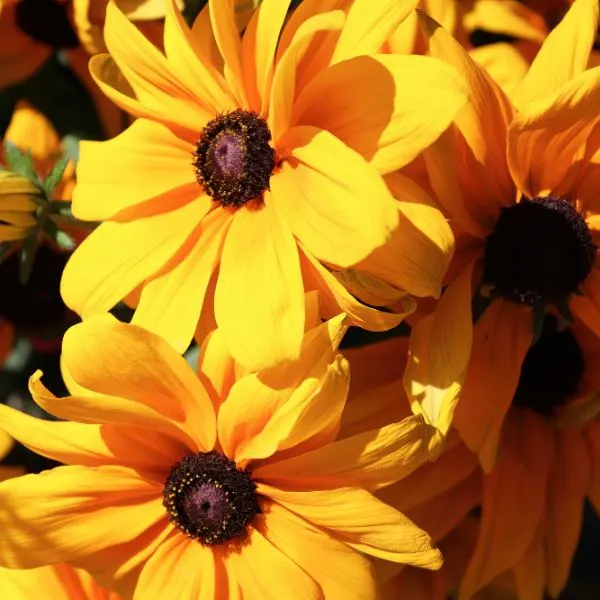
- Botanical name: Rudbeckia hirta
- Sun Requirements: Full sun to partial shade
- Soil Type: Well-drained, average to fertile soil
Black-eyed Susan, a plant of the Asteraceae family, dons a bright yellow color and flaunts a dark center, making it an exceptional flowering plant. This North American native is frequently utilized in gardens as a cut flower or border plant, blooming from summer to fall. It’s a must-have for anyone looking to add vibrancy and color to their garden.
Mixing black-eyed Susan with bee balm creates a stunning, low-maintenance garden that attracts an array of butterflies and pollinators. Black-eyed Susan prefers full sun and moderately fertile, moist soil, requiring partial shade in hotter regions. This perfectly complements bee balm, which thrives under similar growing conditions and has the added benefit of repelling pests.
Providing ample space is crucial when planting black-eyed Susan and bee balm together is crucial. These plants tend to grow vigorously and may compete for space and nutrients if planted too close to each other. However, the upside is that both plants share identical growing conditions, making them excellent companions. Popular black-eyed Susan varieties like Indian Summer, Cherokee Sunset, and Cherry Brandy are just a few options that work exceptionally well with bee balm.
To summarize, black-eyed Susan and bee balm make a splendid pair for anyone seeking to enhance their garden with color and pollinators. With proper growing conditions and adequate spacing, these plants can thrive together and create a spectacular and lively display.
4. Blue Lobelia
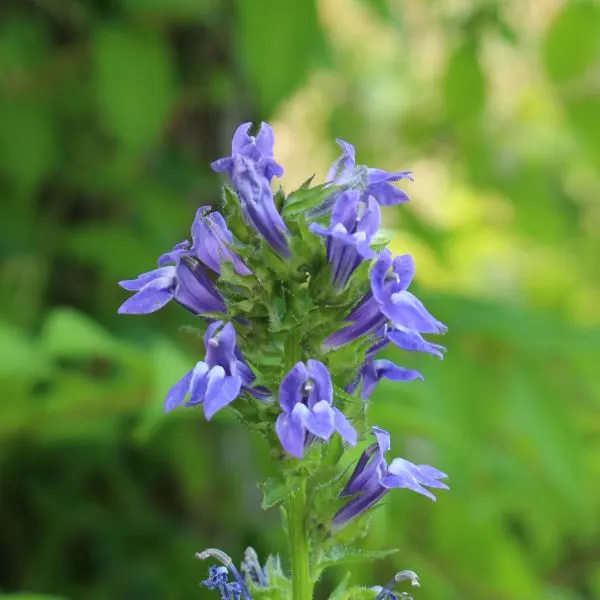
- Botanical name: Lobelia siphilitica
- Sun Requirements: Full sun to partial shade
- Soil Type: Moist to wet, fertile soil
The Great Blue Lobelia, a stunning plant belonging to the Campanulaceae family, is a fantastic addition to any garden bed, with flowers that range in colors from blue to violet and white and which bloom in the late summer. Combined with Wild Bergamot or Bee Balm and two rain garden plants, it creates a garden that is visually pleasing and highly beneficial for pollinators such as native bees, butterflies, and hummingbirds.
A garden bed featuring the Great Blue Lobelia is a true showstopper, with tall spikes of blue flowers that are sure to attract native bumblebees. When this plant is planted alongside Black-Eyed Susans and Bee Balm, a burst of colors is created, making for a tapestry that further lures pollinators to the garden.
However, planning for a succession of blooms throughout the growing season is crucial to create a high degree of perplexity and ensure the greatest benefit to pollinators. Doing so will provide a consistent source of nectar and pollen for bees, butterflies, and other pollinators from the onset of spring through the fall.
In conclusion, planting Great Blue Lobelia with other native rain garden plants is an excellent way to create a stunning and highly beneficial garden for both humans and pollinators alike.
5. Blueberries
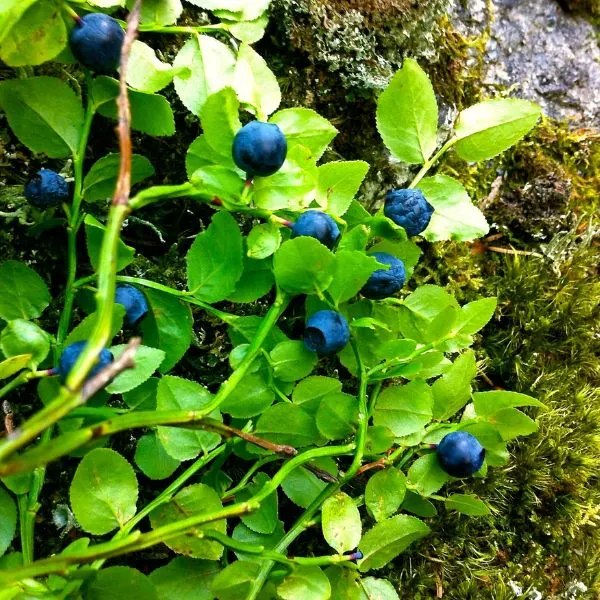
- Botanical name: Vaccinium spp.
- Sun Requirements: Full sun to partial shade
- Soil Type: Well-drained, acidic soil with a pH of 4.5 to 5.5
Blueberries, which are fruit-bearing shrubs belonging to the Ericaceae family, produce sweet, nutritious berries that are blue and can be eaten fresh or used in baking. They prefer acidic soil and are commonly grown in home gardens.
When it comes to pairing plants, blueberries and wildflowers are an excellent match. Wildflowers are not genetically modified and attract a variety of pollinators and beneficial predators, making them the perfect companion for blueberries. Depending on your area, some wildflowers that can be used include Indian paintbrush, Black-eyed Susan, and coneflowers.
Planting bee balm and blueberries together offer numerous benefits. Both plants attract bees and other pollinators, which can improve pollination and increase fruit yields for your blueberry plants. Additionally, blueberries prefer acidic soil, while bee balm thrives in neutral to slightly acidic soil. By planting these two plants together, you can create a microclimate that favors both plants and improves the overall soil quality of your garden.
In addition to improving soil quality and attracting pollinators, planting bee balm near blueberries can also help control pests that can damage your blueberry plants. Ladybugs, lacewings, and parasitic wasps are beneficial insects that can help control pest populations in your garden. Plus, both blueberries and bee balm have attractive foliage and flowers, making them a visually appealing addition to any garden. By utilizing companion planting, you can create a beautiful and healthy garden that benefits both plants and pollinators.
6. Buddleia
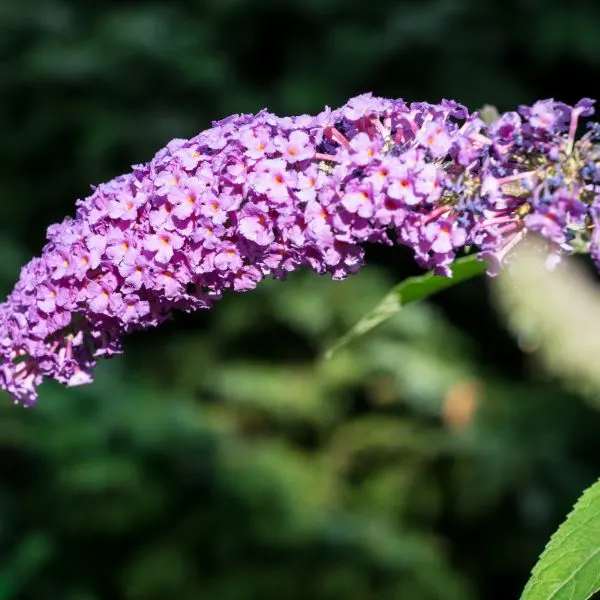
- Botanical name: Buddleja spp.
- Sun Requirements: Full sun to partial shade
- Soil Type: Well-drained, fertile soil
Buddleia, also known as the butterfly bush, is a flowering shrub that belongs to the Scrophulariaceae family. It produces fragrant flowers in shades of purple, pink, white, and yellow that attract butterflies and other pollinators. It is commonly used in gardens as a border plant or as a focal point.
Bee balms and buddleia make great companion plants in a garden. Bee balms benefit from buddleia’s ability to attract pollinators like bees and butterflies. On the other hand, buddleia bushes are also excellent for attracting hummingbirds to your garden with their small, delicate, and brightly colored flowers in purple, blue, pink, or white.
Planting buddleia in spring is highly recommended for optimal growth and blooming. The cutting and deadheading of early flowers during late spring or early summer can prove to be exceptionally advantageous for augmenting the nectar supply, thereby maximizing the food availability for hummingbirds during the later part of the season.
By planting a combination of bee balms and buddleia, the chances of attracting hummingbirds to your garden increase manifold, with minimal upkeep required. Furthermore, the strikingly vivid and flamboyant hues of the flowers of both plants not only cater to the aesthetic appeal of the garden but also serve as a burst of color that can leave onlookers bewildered and in awe.
7. Butterfly Weed

- Botanical name: Asclepias tuberosa
- Sun Requirements: Full sun
- Soil Type: Well-drained, dry to medium moisture, poor to average soil
The mesmerizing Butterfly weed, also known as Asclepias tuberosa, is an exquisite type of milkweed that belongs to the Apocynaceae family. This stunning plant boasts bright orange or yellow flowers that are known to lure in butterflies and other pollinators. It is often used in gardens as a border or wildflower plant to add a pop of color and natural beauty.
Companion planting, a widely used gardening technique that involves planting different species of plants near each other to benefit one another, can enhance the health and productivity of your garden. For instance, Blueberries and bee balm are great companion plants that attract pollinators, improve soil quality, and provide natural pest control. This technique establishes a mutually beneficial relationship that supports a thriving garden ecosystem.
Buddleia bushes are renowned for attracting butterflies; however, they are also great for luring hummingbirds. Planting buddleia and bee balm together can create a constant food source for hummingbirds year after year, with minimal maintenance required. Trimming buddleia during late spring or early summer is recommended to maximize the amount of nectar available for hummingbirds.
Butterfly weed and bee balm are both native plants that can complement each other in a garden setting. They attract pollinators, improve soil quality, and aid in controlling pest populations. Nevertheless, it’s worth noting that butterfly weed is toxic to most humans in large doses, particularly in the sap and roots. Companion planting can create a diverse and visually appealing habitat supporting a thriving garden ecosystem.
8. Columbine
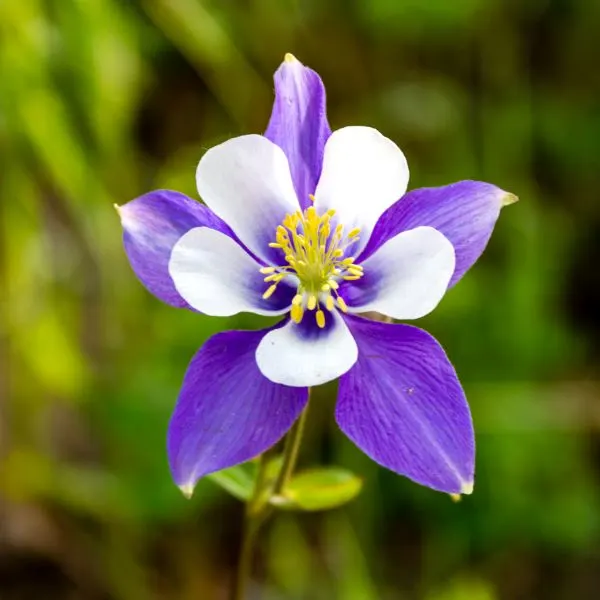
- Botanical name: Aquilegia spp.
- Sun Requirements: Full sun to partial shade
- Soil Type: Well-drained, moist soil
Columbine, a perennial plant from the Ranunculaceae family, features bell-shaped flowers in a range of colors, such as blue, pink, purple, white, and yellow. As a result, it is frequently used as a garden border or rock garden plant.
Planting Columbine and Bee Balm side by side can offer numerous benefits. They attract pollinators such as bees, butterflies, and hummingbirds to your garden and create a diverse habitat that attracts beneficial insects that can help regulate pest populations in your garden.
Columbine and Bee Balm also produce stunning flowers that bloom at various times throughout the growing season. By planting them together, you can continuously display colors and visual interest in your garden.
Moreover, both plants require well-draining soil that is abundant in organic matter, and growing them together can create a microclimate that improves soil quality and promotes healthy growth for both plants.
Columbine, in particular, has the ability to attract beneficial insects like ladybugs and lacewings, which can assist in pest control in your garden. Planting Columbine near Bee Balm can lessen the need for chemical pesticides and provide natural pest control.
As compatible companion plants, Columbine and Bee Balm can mutually benefit from each other’s presence in the garden, creating a diverse and appealing environment that sustains pollinators, enriches soil quality, and regulates pest populations.
9. Coral Bells

- Botanical name: Heuchera spp.
- Sun Requirements: Full sun to partial shade
- Soil Type: Well-drained, fertile soil
Heuchera, commonly known as Coral bells, is a Saxifragaceae family perennial flowering plant that produces delicate, bell-shaped flowers in shades of pink, red, and white. It is often utilized as a border or rock garden plant in gardens.
Pairing Coral Bells and Bee Balm can result in an attractive display of contrasting leaf shapes and colors that add visual interest and color to a garden. Both plants thrive in well-drained soil enriched with organic matter, and planting them together can improve soil quality and promote healthy growth for both plants.
In addition to their aesthetic appeal, Coral Bells and Bee Balm are excellent for attracting pollinators such as bees, butterflies, and hummingbirds to a garden, creating a diverse habitat that attracts beneficial insects.
Coral Bells can also attract ladybugs and lacewings, which prey on common garden pests, and planting them near Bee Balm can help control pest populations and reduce the need for chemical pesticides.
Overall, Coral Bells and Bee Balm are compatible companion plants that support pollinators, improve soil quality, and help control pest populations without competing for resources. By incorporating companion planting strategies, gardeners can cultivate a thriving and functional garden.
10. Coral Honeysuckle
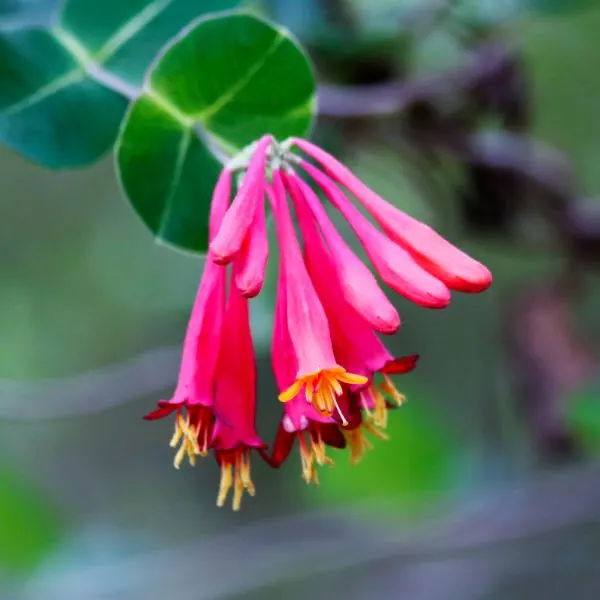
- Botanical name: Lonicera sempervirens
- Sun Requirements: Full sun to partial shade
- Soil Type: Well-drained, moist soil
Coral honeysuckle, a member of the Caprifoliaceae family, is a fragrant vine that produces trumpet-shaped flowers in shades of coral, pink, and red. These blooms are a favorite of hummingbirds and butterflies, making them a popular choice for trellises and groundcovers in gardens.
When planting fragrant plants like Coral Honeysuckle and Bee Balm, it’s important to consider their potential attraction to bees. While they can be placed near windows or patios, it’s important to be mindful of any potential safety concerns.
To create a garden that attracts hummingbirds, a variety of plants can be used, including the firecracker plant, columbine, woodland pinkroot, bee balm, foxgloves, butterfly bush, or salvia.
Coral Honeysuckle and Bee Balm are excellent pairings as companion plants. They attract pollinators, add an aesthetic appeal with their vibrant flowers, provide a natural trellis, improve soil quality, and do not compete for resources. Together, they can create a thriving and visually appealing garden that supports pollinators and promotes healthy growth for both plants.
11. Daisies
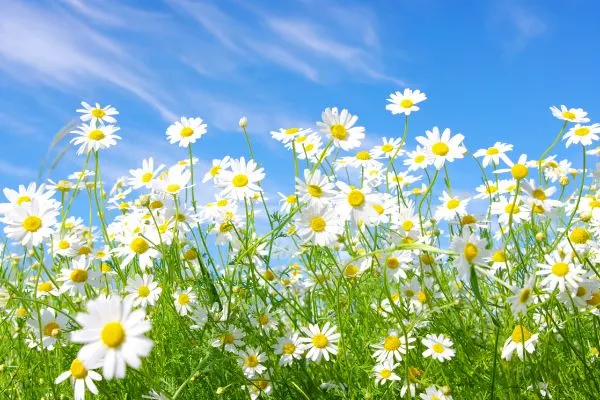
- Botanical name: Bellis perennis, Leucanthemum spp.
- Sun Requirements: Full sun to partial shade
- Soil Type: Well-drained, fertile soil
Daisies, which belong to the Asteraceae family, produce charming white or yellow flowers with a central disk of yellow or brown that attract bees and butterflies. They are frequently used in gardens as a border or wildflower plant.
Planting Daisies together with Bee Balm can provide multiple benefits to your garden. Daisies attract beneficial insects that aid in pollinating Bee Balm flowers and establishing a healthy ecosystem. Furthermore, their deep root system can enhance soil structure, provide more nutrients and water to the Bee Balm plant, and repel harmful pests while adding a pop of color to your garden.
To maximize the advantages of planting Daisies alongside Bee Balm, you can mix them with wildflowers or use them as a border in front of shrubs, lower-growing annuals, or perennials. This can create a more visually appealing and diverse garden that supports pollinators and enhances soil quality.
In summary, combining Daisies and Bee Balm can create a flourishing garden that is both attractive and functional. By using companion planting’s benefits, you can create a natural ecosystem that supports the health and well-being of your plants and the environment around them.
12. Delphinium
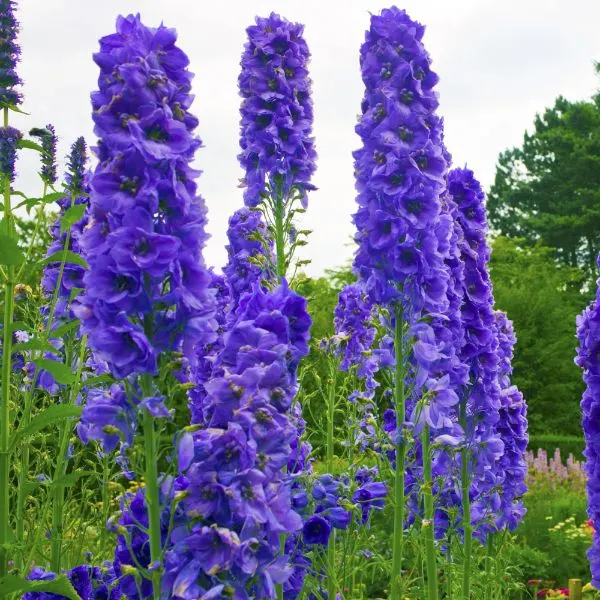
- Botanical name: Delphinium spp.
- Sun Requirements: Full sun
- Soil Type: Rich, well-drained soil
Delphiniums are these really beautiful flowering plants that belong to the Ranunculaceae family. You know, the ones that produce these tall spikes of blue, pink, purple, or white flowers that bloom in late spring to early summer? They’re like the supermodels of the garden world – tall, elegant, and oh-so eye-catching.
But here’s the thing: Delphiniums aren’t just pretty faces. They’re also really great companion plants for Bee Balm. Do you know why? Well, for starters, they attract all sorts of pollinators like bees, butterflies, and hummingbirds that can help pollinate the Bee Balm flowers. It’s like having your own little pollinator party in your garden!
And that’s not all. Delphiniums also have this deep taproot system that works wonders for improving soil structure and nutrient uptake for both plants. So not only do the Delphiniums look stunning next to the Bee Balm, but they’re also helping to make the Bee Balm even healthier. It’s like they’re the ultimate power couple in the garden.
But wait, there’s more! Delphiniums also act as a natural trellis for the Bee Balm plant, which is great for taller varieties that might be prone to falling over. The Delphiniums provide support for the Bee Balm stems, keeping them upright and looking their best.
Oh, and one more thing: Delphiniums and Bee Balm bloom at different times, which means you get a continuous source of blooms and visual interest in your garden throughout the growing season. It’s like having your own private flower show all season long!
So, if you want to create a beautiful and beneficial garden environment for plants and pollinators, consider planting Delphiniums alongside Bee Balm. Trust me, your garden (and the bees and butterflies) will thank you!
13. Echinacea
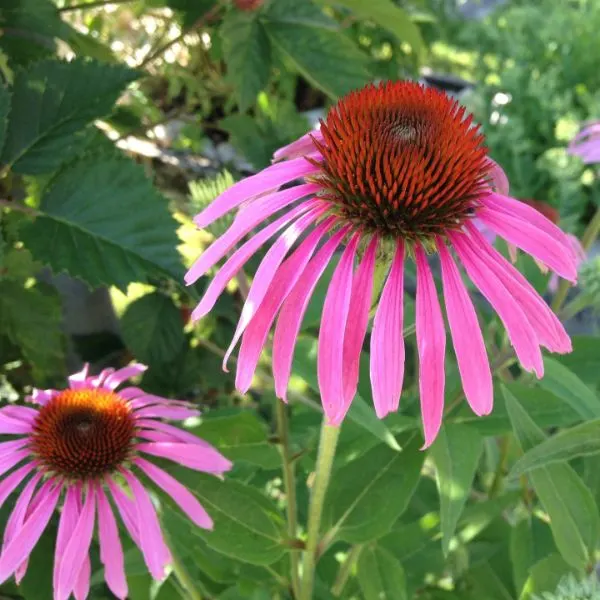
- Botanical name: Echinacea spp.
- Sun Requirements: Full sun to partial shade
- Soil Type: Well-drained, average to fertile soil
Echinacea also called coneflower, is a lovely flowering plant that belongs to the Asteraceae family. It flaunts big, flashy flowers in shades of pink, purple, and white that attract bees and butterflies. You can typically spot this plant in gardens as a border or wildflower.
Bee Balm and Echinacea plants are awesome buddies in the garden. They both have the ability to draw in helpful insects and pollinators like bees and butterflies, which can aid with plant reproduction. Although Echinacea plants are vulnerable to aphid infestations, bee balms draw in ladybugs that feast on aphids and other pests, helping to control the damage caused by these pests in the garden.
You can also plant coneflowers alongside bee balms since they share similar growing conditions and heights. Coneflowers come in a range of colors, making them a fantastic choice if you’re searching for a splash of color variety in your garden. Black-eyed Susans also make great companions for bee balms, as they can handle their growing tendencies.
Apart from their practical benefits, bee balms, echinacea, and coneflowers can add to your garden’s visual appeal with their stunning flowers. However, bee balms prefer well-drained soil with consistent moisture, as they are not as drought-resistant as some other plants. Combining these plants together can create a lovely and beneficial garden environment for both plants and pollinators.
14. Eupatorium
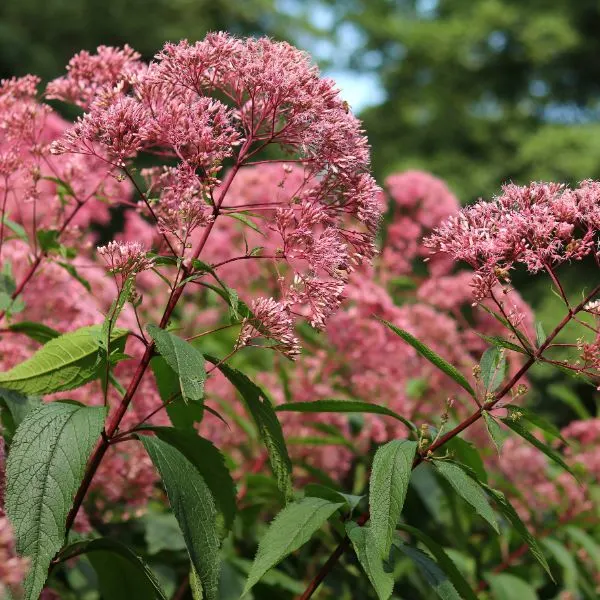
- Botanical name: Eupatorium spp.
- Sun Requirements: Full sun to partial shade
- Soil Type: Moist to wet, fertile soil
Eupatorium, a genus of North American perennials commonly known as “Joe Pye Weed.” From mid-summer to early fall, Eupatorium produces clusters of beautiful pinkish-purple flowers that are sure to catch the eye of butterflies and bees.
But why stop there? For a winning garden combination, pair Eupatorium with another butterfly magnet: Bee Balm. These two plants can tolerate a wide range of conditions, including rain gardens with moist soils.
By planting Eupatorium alongside Bee Balm, gardeners can create a thriving ecosystem that benefits both the plants and the pollinators that visit them. Eupatorium’s deep taproot system can improve soil structure and water retention while also providing shade and shelter for Bee Balm. Plus, Eupatorium’s different blooming seasons can keep your garden looking beautiful and interesting throughout the growing season.
What’s more, Eupatorium also repels harmful pests, making it a great addition to any garden. So, why not try this dynamic duo in your garden and enjoy a healthy, thriving ecosystem that’s sure to impress?
15. Evening Primrose
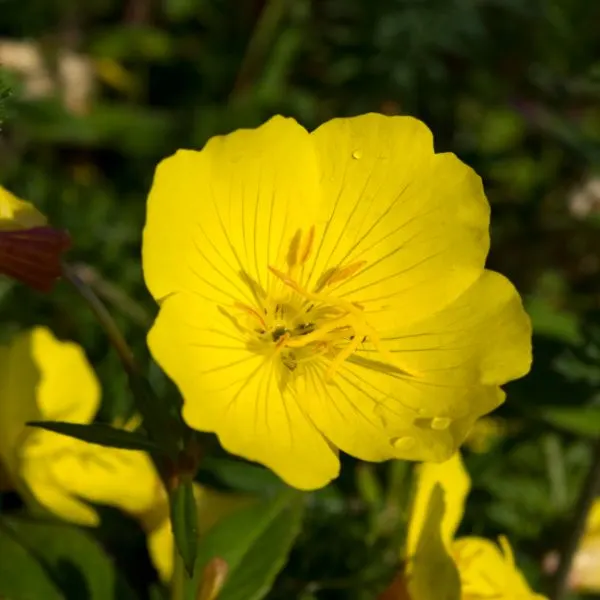
- Botanical name: Oenothera spp.
- Sun Requirements: Full sun
- Soil Type: Well-drained, poor to average soil
Evening primrose is a beautiful flowering plant that can be found in North America. Its yellow flowers bloom in the evening and attract pollinators like moths. People use evening primrose oil for its anti-inflammatory properties and skincare benefits.
If you want to grow evening primrose in your garden, make sure to plant it in a shady area with moist soil. But not all plants can handle such conditions. Luckily, you can plant evening primrose alongside bee balm to offer many benefits.
Firstly, evening primrose attracts important pollinators like moths that can increase pollination rates for bee balm, leading to improved fruit and seed production. Additionally, its deep taproot system can improve soil structure and nutrient uptake, promoting healthier growth for bee balm.
Furthermore, evening primrose can repel certain pests like spider mites and aphids, keeping your bee balm safe from harm. The bright, showy flowers of evening primrose also add visual interest to your garden and create a diverse environment for both you and the pollinators. Plus, since evening primrose blooms at a different time than bee balm, you can enjoy continuous blooms and visual interest throughout the growing season.
In summary, planting evening primrose alongside bee balm can create a healthy and diverse garden environment for both the plants and the pollinators that visit them.
16. Ferns
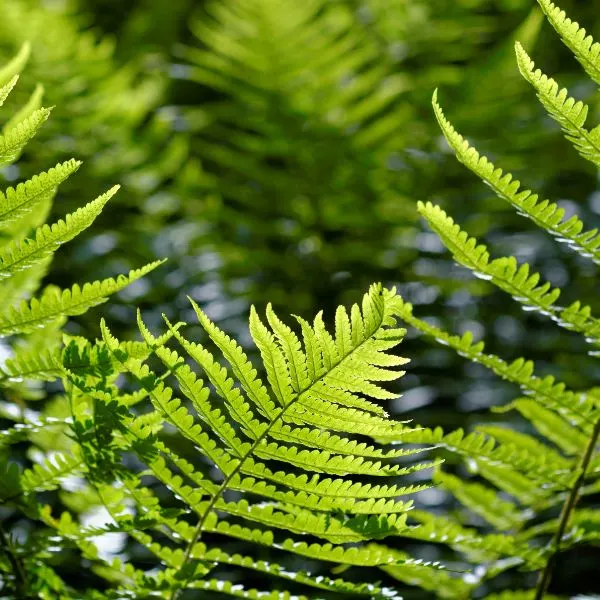
- Botanical name: Polypodiopsida
- Sun Requirements: Full shade to partial shade
- Soil Type: Moist, well-drained soil
Ferns are a group of non-flowering plants that reproduce through spores. They are found in various habitats, from tropical rainforests to temperate woodlands. They are known for their unique fronds and can be grown as houseplants or in outdoor gardens.
Ferns and Bee Balm are two plants that can complement each other well in a garden. They have different textures and foliage that can add interest and contrast to the garden while thriving in similar growing conditions. Planting them together can create an aesthetically appealing and functional garden that supports pollinators, improves soil quality, and helps control weed growth.
Ferns are shade-loving plants that prefer moist, well-drained soil, which provides an excellent microclimate for Bee Balm to grow. By planting them near Bee Balm, they can provide shade for the plant during the hottest part of the day, which can help it conserve moisture and prevent sunburn. Additionally, ferns can help suppress the growth of weeds by shading the soil and reducing the amount of sunlight that reaches the ground, which reduces the need for herbicides and other chemical controls.
Ferns and Bee Balm are known to be compatible companion plants. They do not compete for resources and can benefit from each other’s presence in the garden. Planting them together can improve soil quality, promote healthy growth, and create a thriving garden that is both beautiful and sustainable. Overall, these plants can create a functional and attractive garden that supports the health and well-being of both plants and pollinators.
17. Fleabane
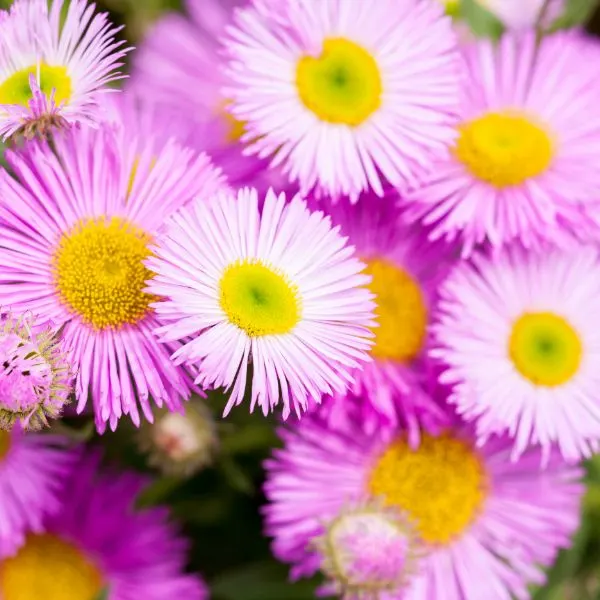
- Botanical name: Erigeron spp.
- Sun Requirements: Full sun to partial shade
- Soil Type: Well-drained, average to poor soil
Fleabane is a member of the Asteraceae family with over 100 different species. These plants produce clusters of small, daisy-like flowers that can be white, pink, or purple. Some types of Fleabane are weeds, but others are grown as ornamental plants in gardens.
When planted alongside Bee Balm, Fleabane can offer several benefits. Firstly, it attracts a wide range of pollinators that can increase the pollination of Bee Balm flowers. Secondly, its low-growing habit can act as a natural ground cover, keeping weeds at bay and retaining moisture in the soil. Additionally, Fleabane repels certain pests, keeping your Bee Balm safe and healthy.
Apart from its functional advantages, Fleabane adds aesthetic interest to your garden with its daisy-like flowers and delicate foliage. Plus, since it blooms at a different time than Bee Balm, you can enjoy continuous blooms throughout the growing season.
By planting Fleabane alongside Bee Balm, you can create a diverse and healthy garden environment that benefits both plants and pollinators. So, try companion planting to enhance the beauty and health of your garden in a sustainable way.
18. Foxglove
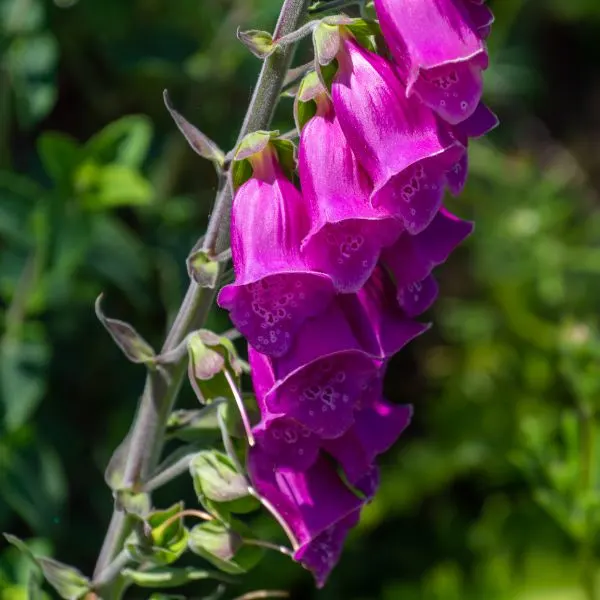
- Botanical name: Digitalis spp.
- Sun Requirements: Full sun to partial shade
- Soil Type: Well-drained, moist to average soil
Foxglove is a plant with tall spikes of tubular flowers that can be white, pink, or purple. It’s part of the Plantaginaceae family and was originally from Europe but is now found all around the world. Gardeners love using Foxglove in their cottage gardens. One of the interesting things about this plant is that it contains chemicals used to make the heart medication digitalis.
In recent years, creating bee gardens has become a popular trend due to the decline in bee populations. Bees need food sources throughout the seasons to stay healthy, and planting flowers like borage, calendula, hyacinth, and bee balm in the summer and asters and goldenrod in the autumn can help. By providing these plants, you can attract bees to your garden and help boost plant production.
Foxglove is a tall plant that pairs nicely with Bee Balm in a garden setting. It attracts pollinators like bees and hummingbirds, which can help increase the pollination of Bee Balm flowers and improve fruit and seed production. Additionally, Foxglove can repel pests like spider mites and aphids, protect the Bee Balm plant, and add to the garden’s biodiversity.
The different blooming seasons of Foxglove and Bee Balm can create continuous visual interest and add to the garden’s vertical appeal. The height and delicate flowers of Foxglove make for a beautiful backdrop to the Bee Balm. In summary, planting Foxglove alongside Bee Balm can create a diverse and visually appealing garden that benefits both plants and pollinators.
19. Giant Coneflower
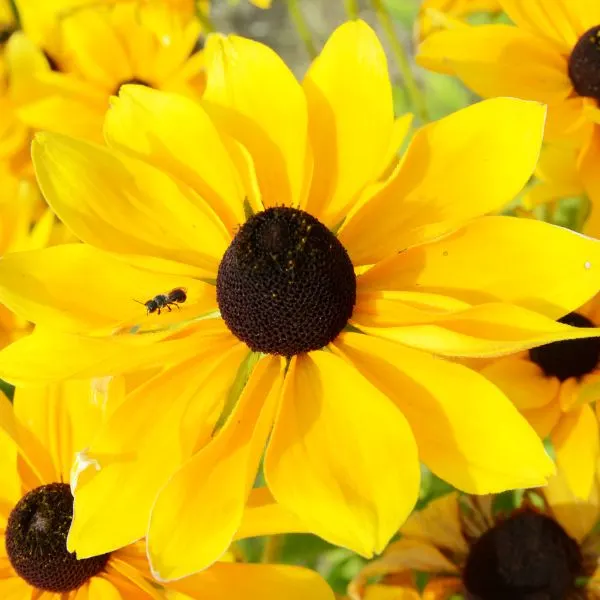
- Botanical name: Rudbeckia maxima
- Sun Requirements: Full sun
- Soil Type: Well-drained, average to poor soil
Giant coneflower, or Rudbeckia maxima, is a tall and striking plant that produces large, yellow flowers with dark brown centers. It’s a native perennial from the central US and can grow up to 10 feet tall! When planted with Bee Balm, these two plants make a great team. They love the same conditions, and together they can create a beautiful and carefree garden for butterflies, pollinators, and herb lovers.
Giant coneflower has a deep taproot system that helps improve soil structure and nutrient uptake, making it a great companion for Bee Balm. When planted together, they attract a wide variety of pollinators, repel certain pests, and create a visually stunning garden with their tall stems and showy flowers.
Another benefit of planting these two together is that they bloom at different times during the growing season, ensuring a continuous source of blooms. This mixture can create a healthy and diverse environment that benefits both the plants and the pollinators that visit them.
Overall, planting Giant coneflower alongside Bee Balm is an excellent way to create a lovely garden that attracts pollinators, repels pests, and improves soil structure. It provides a beautiful and diverse garden environment for everyone to enjoy.
20. Hardy Hibiscus
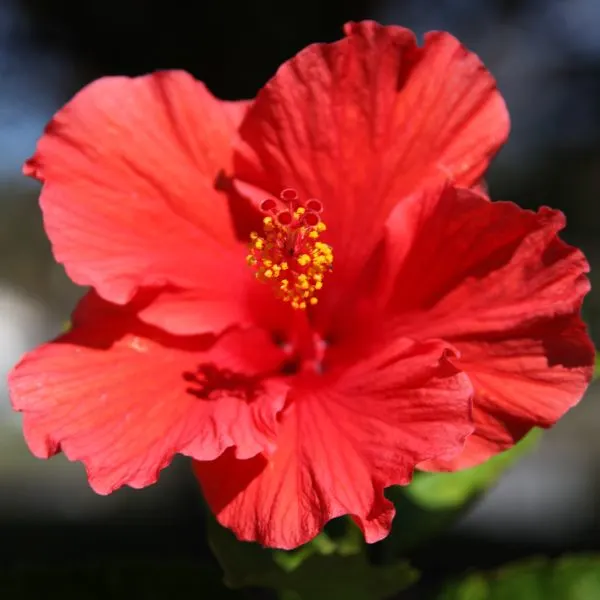
- Botanical name: Hibiscus moscheutos
- Sun Requirements: Full sun to partial shade
- Soil Type: Moist, well-drained soil
Looking to create a gorgeous garden? Try planting some bee balm alongside your hibiscus plants! Bee balm is a stunning wildflower native to North America with fuchsia purple flowers that look fantastic as a ground cover for hibiscus. Although petite compared to hibiscus, bee balm prefers similar growing conditions.
One of the benefits of planting bee balm with hibiscus is the striking contrast of colors. The scarlet, pink, white, purple, and lavender shades of bee balm complement the dark hibiscus leaves perfectly. Bee balm also boasts a long blooming season that lasts longer than that of hibiscus. Your garden will be teeming with life for many months.
When selecting a bee balm variety to plant with hibiscus, be sure to choose a non-aggressive spreader to avoid competition for space. Both plants thrive in full sun and moist soil, making them ideal companions. By planting bee balm and hibiscus together, you can create a stunning and vibrant garden that will grab everyone’s attention and admiration.
21. Hydrangea
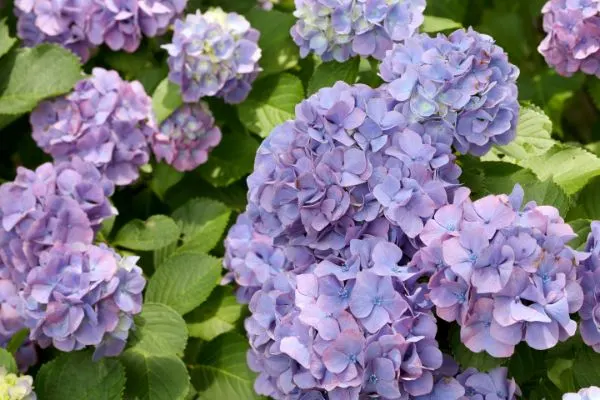
- Botanical name: Hydrangea macrophylla
- Sun Requirements: morning sun and afternoon shade, especially in hot climates. They can tolerate the full sun in cooler climates.
- Soil Type: moist, well-drained soil that is rich in organic matter. The soil should be slightly acidic, with a pH between 5.2 and 6.2.
Hydrangeas are a showstopper with their big bunches of blooms in all sorts of shades. These shrubs enjoy soil that’s kept moist but not overly wet and a bit of shade to protect them from the hot sun.
Pairing bee balm with Bobo Hydrangeas is a smart move. The two plants look great together, providing contrast in color and texture. As for Blue Spruce, it’s unclear what benefits it brings to this particular gardening project, but it’s always worth experimenting!
22. Lilac
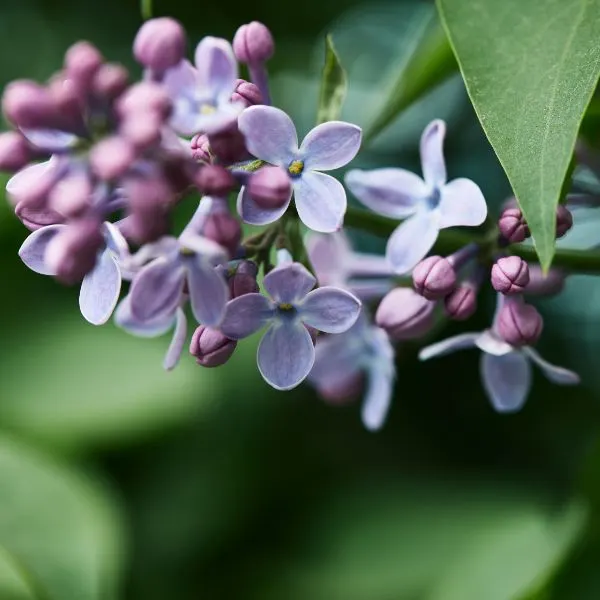
- Botanical name: Syringa vulgaris
- Sun Requirements: Full sun to partial shade
- Soil Type: well-draining soil with a pH range of 6 to 7.5
Lilacs are like the superstars of the garden world! They’re small trees or shrubs that come in a range of shades from pink and purple to white, and they smell amazing! These beauties love basking in full sun and prefer soil that’s not too soggy.
But wait, it gets better! Lilacs and bee balm make amazing garden buddies! They both attract pollinators like bees, butterflies, and hummingbirds while also keeping each other company. Planting bee balm with lilacs can even help deter pesky aphids that can munch on bee balm. Plus, they look great together, with their blooming seasons overlapping to give you a long season of interest in your garden.
Here’s the cool part: lilacs have an incredible scent that can help protect bee balm from certain pests, and bee balm can help prevent soil erosion around the lilac plant. Together, they make for a visually stunning garden space that’s bursting with life and energy. With their combined benefits of attracting pollinators, repelling pests, providing shade and shelter, complementing each other aesthetically, and offering a long season of interest, planting lilacs and bee balm together is a fantastic way to create a garden that’s both beautiful and functional.
23. Milkweed
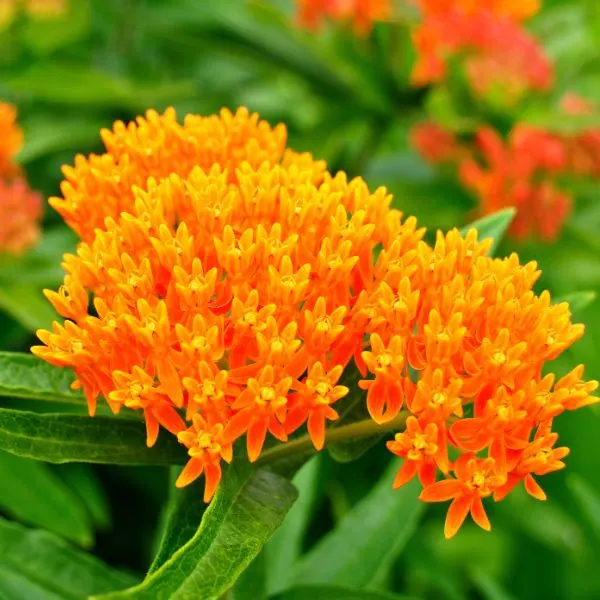
- Botanical name: Asclepias spp.
- Sun Requirements: Full sun
- Soil Type: Well-drained soil of varying pH levels
Milkweed is a plant genus renowned for its attractive flowers and milky sap. Its importance, however, extends far beyond aesthetics. Monarch butterflies and other pollinators rely on milkweed as a vital food source. And the best part? It’s incredibly easy to grow! Give it plenty of sunshine and well-drained soil, and you’ll have yourself a thriving milkweed garden.
But did you know that milkweed is also a fantastic companion for Bee Balm? Planting them side by side offers several benefits. For one, milkweed acts as a host plant for Monarch butterflies, boosting their population and pollinating the Bee Balm. Additionally, its sturdy structure provides natural support for the Bee Balm plant.
Milkweed’s deep taproot system helps improve soil structure and nutrient uptake, giving Bee Balm the boost it needs to flourish. What’s more, milkweed is a magnet for a diverse range of pollinators like bees and butterflies, which means more pollination and better fruit and seed production for Bee Balm.
And the icing on the cake? Milkweed blooms at a different time than Bee Balm, creating a gorgeous and continuous display of flowers. So, planting milkweed alongside Bee Balm is a win-win for both plants and pollinators, creating a healthy and diverse garden environment.
24. Mistflower

- Botanical name: Conoclinium coelestinum
- Sun Requirements: Full sun to partial shade
- Soil Type: Moist, well-drained soil of varying pH levels
Mistflower is a beautiful plant that produces clusters of daisy-like flowers in blue and purple. These flowers are a vital source of nectar for butterflies and other pollinators. If you’re looking to create a vibrant and visually appealing garden, you might want to consider planting Mistflower alongside Bee Balm.
Mistflower and Bee Balm share similar growing requirements, which means they can be grown together without fighting over resources. Mistflower’s blue-purple flowers provide a lovely contrast to Bee Balm’s pink, red, or purple flowers, adding an extra pop of color to your garden.
One of the best things about Mistflower is that it’s low-maintenance and easy to care for. Even better, it attracts pollinators like bees, butterflies, and moths, which can help increase pollination rates for Bee Balm. Plus, Mistflower’s ability to spread easily through rhizomes means it can fill empty spaces in your garden and create a more natural-looking landscape.
Overall, if you’re looking for a beautiful, low-maintenance plant that can attract pollinators and add color to your garden, you can’t go wrong with Mistflower. Give it a try alongside Bee Balm, and see how it transforms your garden into a thriving, visually stunning space.
25. New England Aster
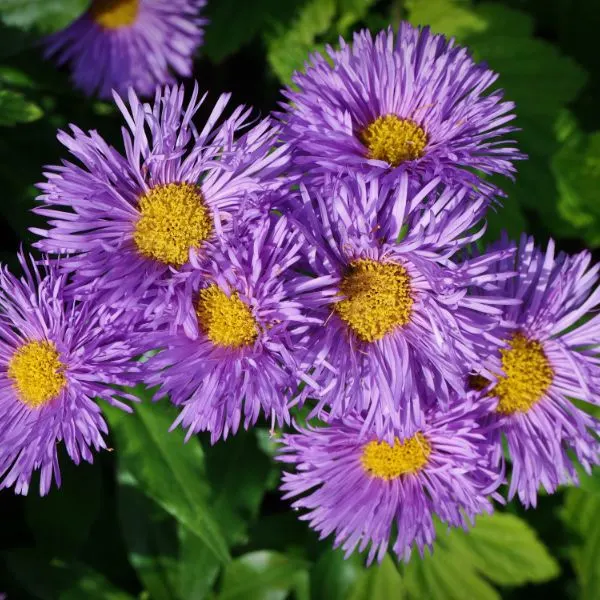
- Botanical name: Symphyotrichum novae-angliae
- Sun Requirements: Full sun to partial shade
- Soil Type: Moist, well-drained soil of varying pH levels
New England Aster is a native perennial plant that produces clusters of lovely daisy-like flowers in shades of pink, purple, and white. It thrives in full sun and well-drained soil, and it’s a hit with butterflies and other pollinators.
The good news is that New England Aster is an excellent companion plant for Bee Balm. They both prefer similar growing conditions and can create a natural-looking garden that’s easy on the eyes. Plus, New England Aster is tall and sturdy, providing essential support to Bee Balm and attracting an array of pollinators. This, in turn, increases pollination rates for Bee Balm and boosts its growth.
New England Aster also blooms at a different time than Bee Balm, providing a continuous display of flowers throughout the growing season. And that’s not all. Its deep roots improve soil health, increasing nutrient and water uptake, which benefits Bee Balm even more.
By planting New England Aster with Bee Balm, you’ll create a healthy and diverse garden environment that supports native plant species and pollinators. So, go ahead and add some New England Aster to your garden. Your Bee Balm will thank you!
26. Ornamental grasses
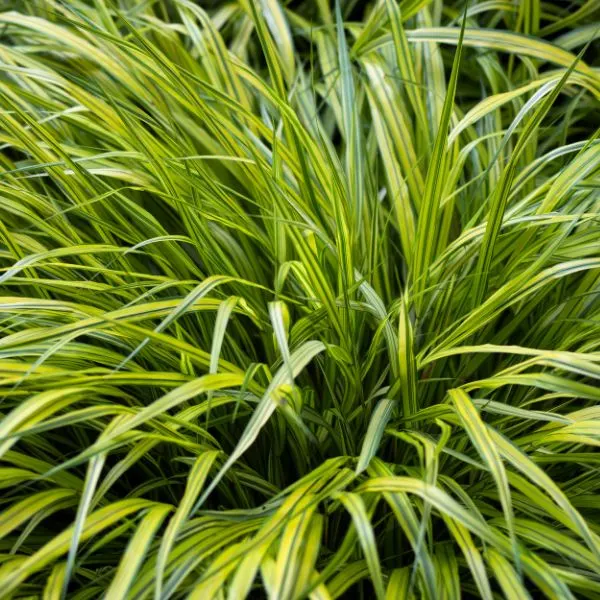
- Botanical name: Various
- Sun Requirements: Full sun to partial shade, depending on the species
- Soil Type: Well-drained soil of varying pH levels depending on the species
Ornamental grasses are like the cool kids of the garden world – they bring the texture, the color, and the swaying movement that makes everyone else jealous. Whether you want to add some flair to your garden beds or create a stunning focal point, ornamental grasses are the way to go.
But here’s the best part: they’re not just good for looks. Ornamental grasses are great companions for Bee Balm because they provide visual contrast and shelter for beneficial insects and wildlife. Plus, they’re low-maintenance and drought-tolerant, just like Bee Balm.
In fact, some ornamental grasses like bluestem (Andropogon gerardi) can even help prevent soil erosion, making them a natural solution for sloping areas. And their root systems won’t compete with Bee Balm for nutrients, so they won’t steal the spotlight from your favorite plant.
Planting ornamental grasses with Bee Balm is a smart move for creating a sustainable and diverse garden ecosystem. Just make sure you choose varieties that are well-suited to your climate and soil conditions. With the right mix of grasses and plants, your garden will be the envy of the neighborhood.
27. Penstemon
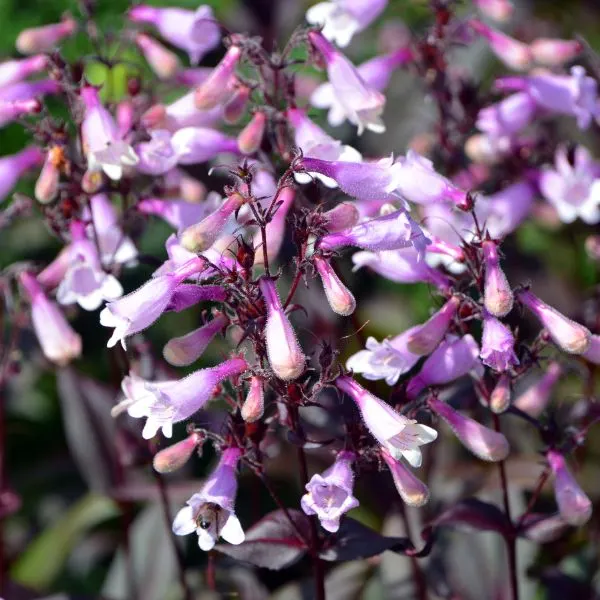
- Botanical name: Penstemon spp.
- Sun Requirements: Full sun to partial shade, depending on the species
- Soil Type: Well-drained soil with a pH range of 5.5 to 7.0
Penstemon is a genus of flowering perennials that produce showy, tubular flowers in shades of pink, purple, blue, and white. They love basking in the sun and growing in soil that is well-drained. The best part is that they attract hummingbirds and other pollinators, making them a valuable addition to any garden.
When planted alongside Bee Balm, Penstemon makes for an excellent companion plant. The two plants are like peas in a pod, attracting pollinators such as bees, butterflies, and hummingbirds. Their colors and textures complement each other perfectly. Bee Balm’s bright, showy flowers pop against Penstemon’s slender, spiky blooms, creating a stunning visual display.
Penstemon also adds structure and height to a garden, creating layers that add depth and dimension. It’s a natural pest control option, too, thanks to the compound pesticides that repel certain pests like spider mites and aphids. Both plants prefer well-drained soil, so planting them together can improve soil quality and promote healthy growth.
Overall, planting Penstemon and Bee Balm together is a fantastic way to create an attractive, sustainable garden that supports pollinators, improves soil quality, and offers natural pest control.
28. Peonies
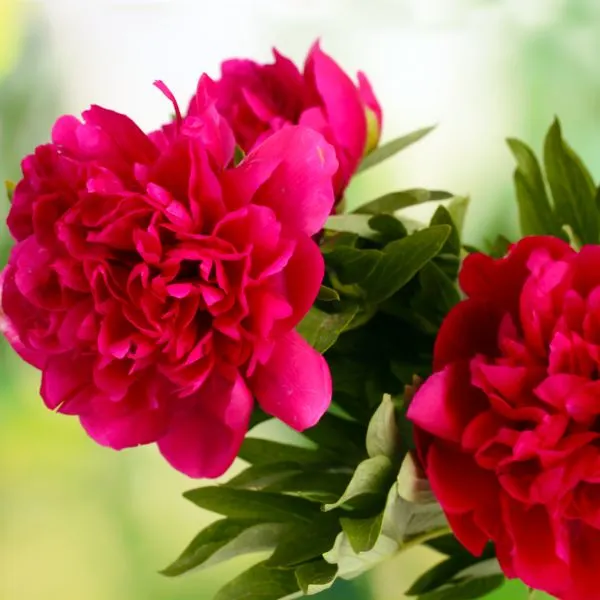
- Botanical name: Paeonia spp.
- Sun Requirements: Full sun to partial shade
- Soil Type: Well-drained soil of varying pH levels
Peonies are the perfect addition to any garden, producing stunning, large flowers in a range of colors like pink, red, white, and yellow. They thrive in full sun and well-drained soil and are popularly used for cut flowers.
Peonies and Bee Balm are a great match when it comes to companion planting. Peonies can add height and structure to your garden bed while creating a stunning visual effect when planted with Bee Balm. Plus, they bloom at different times, providing a continuous display of flowers throughout the season.
Since peonies and Bee Balm share similar soil and sun requirements, they can create a well-balanced garden environment that benefits both native and non-native plant species. Peonies have deep roots that help to improve soil structure and nutrient uptake, which can benefit Bee Balm’s growth.
Planting peonies alongside Bee Balm can attract helpful insects like bees and butterflies, improving pollination rates and leading to healthier growth. Just make sure to give them enough space to avoid shading out smaller plants like Bee Balm.
Overall, planting peonies and Bee Balm together can create a stunning and healthy garden environment that supports the plants and the wildlife that come to visit.
29. Phlox
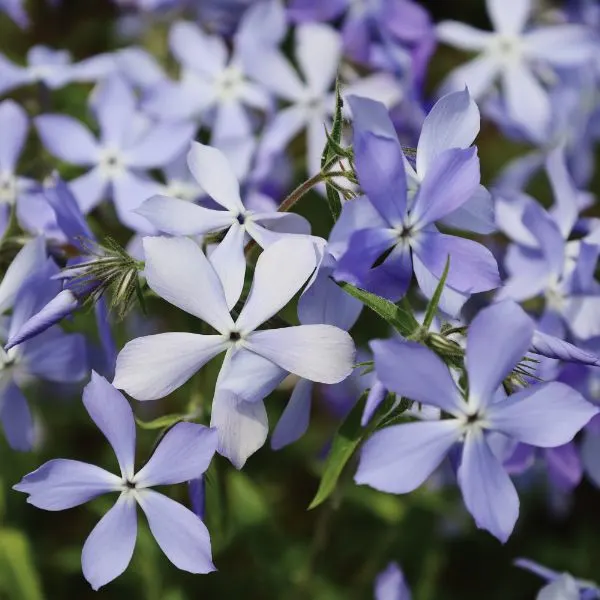
- Botanical name: Phlox paniculata
- Sun Requirements: Full sun to partial shade
- Soil Type: Moist, well-drained soil with a pH range of 6.0 to 7.0
Phlox is a flowering perennial that can add pops of color and fragrance to your garden. Its clusters of pink, purple, and white flowers are not only beautiful, but they also attract pollinators like butterflies and bees. Phlox can even act as a ground cover, keeping weeds at bay.
If you’re planting scarlet bee balm, consider planting phlox nearby. Choose phlox varieties that complement the bee balm’s color, and give them enough space to spread out, or plant shorter phlox in front of taller bee balm.
Bee balm is also a great companion for other native plants, like Penstemon and peonies. By planting these together, you’ll create a visually interesting and dynamic landscape that supports a variety of plant species and beneficial insects. Plus, these plants can improve the quality of your soil.
To ensure the best growth for your phlox, plant it in well-drained and humus-rich soil, and give it plenty of sunshine. With its showy blooms and ability to attract pollinators, phlox is an excellent addition to any garden.
30. Pumpkins
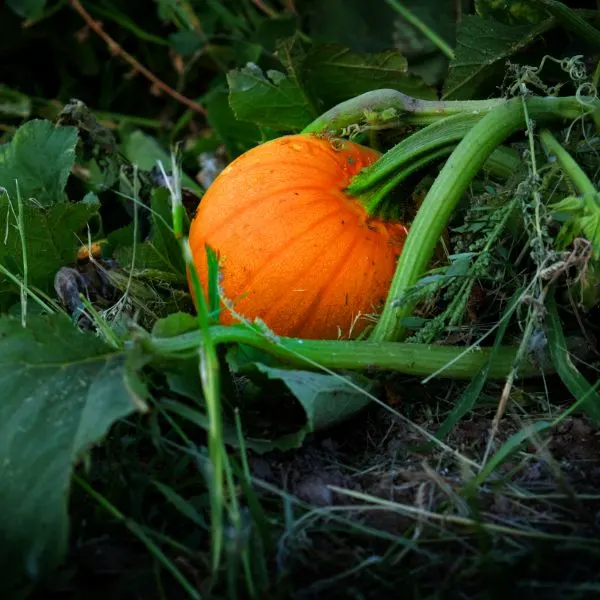
- Botanical name: Cucurbita pepo
- Sun Requirements: Full sun
- Soil Type: Rich, well-drained soil with a pH range of 6.0 to 7.0
Pumpkins are a type of winter squash that is widely used for decorative and culinary purposes. These sun-loving plants need well-drained soil and are typically grown during fall to be used in Halloween decorations or in delicious Thanksgiving pies.
Although pumpkins can be invasive, they can also make great companions for Bee Balm. The colorful flowers of these plants contrast well with the red, purple, pink, and white blooms of Bee Balm, making for a visually appealing garden.
Planting pumpkins and Bee Balm together can provide several benefits. Both plants attract pollinators, which can create a lively garden environment. Furthermore, Bee Balm’s deep root system can help improve soil quality and drainage, which is beneficial for pumpkin plants that require plenty of nutrients.
Pumpkins and Bee Balm are also compatible companion plants that offer natural pest control. Bee Balm repels pests and attracts predatory insects, while the large leaves of pumpkin plants can provide shade and regulate moisture levels. Pumpkins’ bright orange color also adds a pleasing contrast against Bee Balm’s colorful blooms.
Overall, planting pumpkins and Bee Balm together can create an attractive and productive garden that supports pollinators, improves soil quality, and provides natural pest control.
31. Rhododendrons
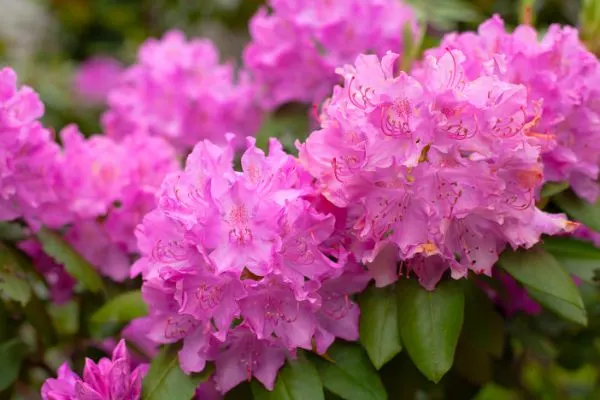
- Botanical name: Rhododendron spp.
- Sun Requirements: Partial to full shade, depending on the species
- Soil Type: Well-drained, acidic soil with a pH range of 4.5 to 6.0
Rhododendrons are a great choice for any garden, as their large, bold blooms in shades of pink, purple, red, and white are a real showstopper. These shrubs prefer partial shade and acidic soil, making them a popular focal point in many gardens.
If you’re looking for a stunning combination, try planting Rhododendrons alongside Bee Balm. These two plants share similar sun and soil requirements, and together they create a breathtaking display that lasts from late spring to early summer. Rhododendrons also provide permanent structure to the garden bed, adding height and visual interest.
In hot and dry climates, Rhododendrons can also create a microclimate for Bee Balm by reducing the amount of direct sunlight that reaches the ground. This is important for keeping your plants healthy and thriving. Additionally, Rhododendrons are a magnet for beneficial insects like bees and butterflies, which can improve pollination rates for Bee Balm, leading to better fruit and seed production.
But be careful not to overcrowd your garden with Rhododendrons, as they can grow quite large and shade out smaller plants like Bee Balm if planted too closely together. It’s also important to make sure your Rhododendrons are planted in well-draining soil to prevent root rot. By planting Rhododendrons alongside Bee Balm, you can create a stunning and healthy garden that will be a haven for wildlife.
32. Roses
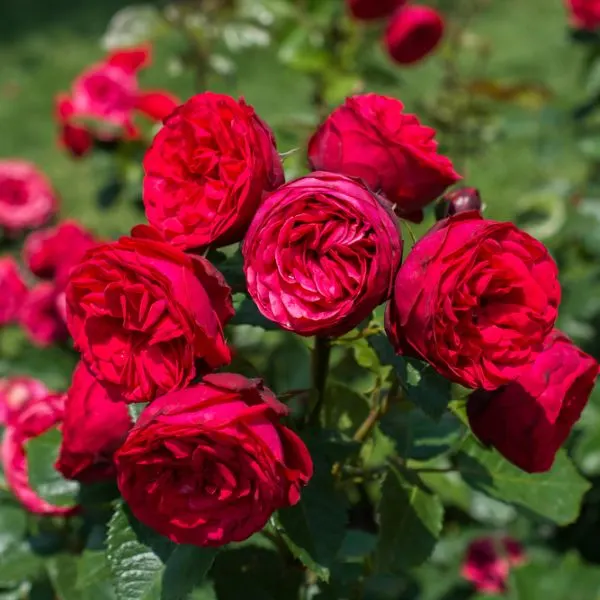
- Botanical name: Rosa spp.
- Sun Requirements: Full sun to partial shade, depending on the species
- Soil Type: Well-drained soil of varying pH levels depending on the species
Roses are one of those classic flowering shrubs that just can’t be beaten. They’re fragrant and colorful and come in all sorts of sizes and colors, making them the perfect focal point in any garden or landscape. Just remember, they like full sun and well-drained soil.
Bee balm is a fantastic companion for roses because it’s a magnet for pollinators like bees and hummingbirds while also repelling common pests like aphids and whiteflies. But don’t plant it in front of your roses, or they’ll compete for nutrients, and watch out for powdery mildew, which can be a problem for both plants.
Since bees, hummingbirds, and butterflies all love bee balm, planting it alongside roses can create a thriving garden that benefits a variety of beneficial insects. This not only helps with pollination but also makes for a healthier overall garden environment.
All in all, planting bee balm and roses together can create a beautiful and productive garden that supports pollinators, repels pests, and improves the health of your plants. Just be sure to choose a bee balm variety that complements the size of your roses, and keep an eye out for powdery mildew.
33. Shrubs
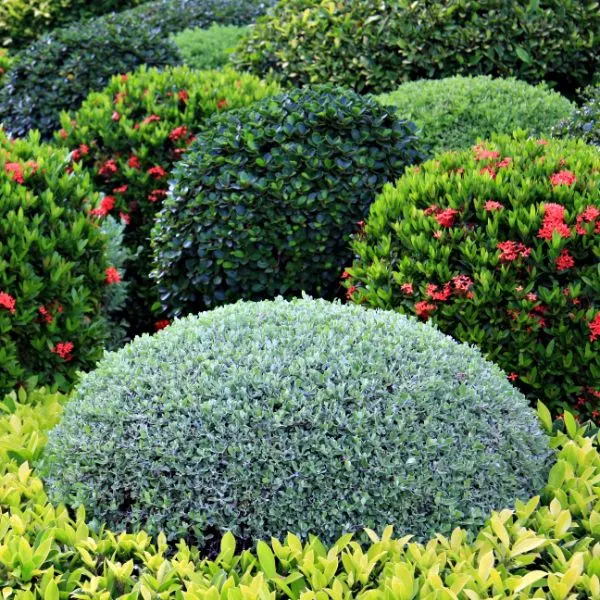
- Botanical name: Various
- Sun Requirements: Full sun to partial shade, depending on the species
- Soil Type: Well-drained soil of varying pH levels depending on the species
Shrubs come in all shapes and sizes and can be evergreen or deciduous. They add color and texture to a garden and are often used to provide structure and interest.
Bee Balm and shrubs are a match made in gardening heaven! Shrubs like Hydrangea and Viburnum complement Bee Balm’s bright blooms and provide a backdrop for the plant. Plus, they attract beneficial insects and wildlife, making the garden a happier and healthier place.
Shrubs can also act as a shield for Bee Balm in windy areas, creating a microclimate that helps the plant thrive. The butterfly bush (Buddleja) is particularly popular with pollinators and can serve as a valuable food source.
In addition to adding structure to a garden, shrubs can be used to define borders, create privacy screens, or add height and texture. However, it’s important to choose the right shrubs for the growing conditions and give both the shrub and Bee Balm enough space to flourish.
Overall, adding shrubs to a garden with Bee Balm is a fantastic way to enhance its beauty and create a healthier ecosystem.
34. Squash
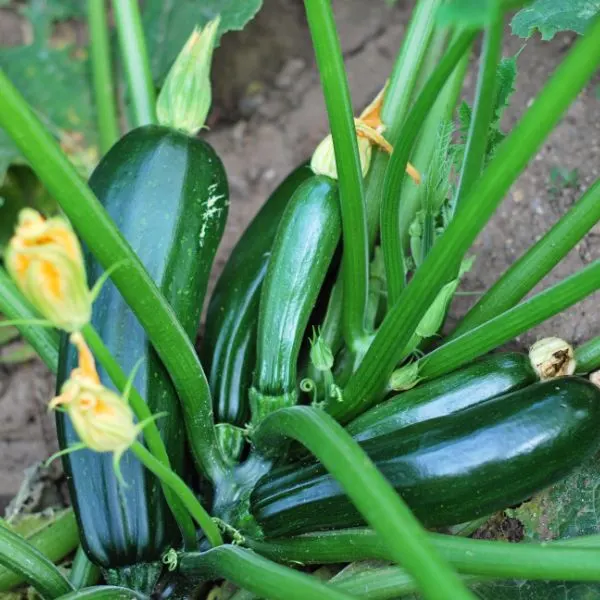
- Botanical name: Cucurbita spp.
- Sun Requirements: Full sun
- Soil Type: Rich, well-drained soil with a pH range of 6.0 to 7.0
Let’s talk about squash! It’s a tasty fruit that grows on plants in the cucurbit family. Squash plants have big leaves and flowers that come in a variety of colors, like yellow, green, and orange. They need lots of sunlight and well-drained soil to thrive.
If you’re growing squash, Bee Balm is a great companion plant. It can help repel insects that can harm the squash plant and attracts helpful bugs like lady beetles and paper wasps that eat pests like aphids and caterpillars. Bee Balm also attracts pollinators that can boost your squash yield.
When planting Bee Balm with squash, it’s important to give the squash enough room to grow since it can get big and take over a lot of space. The Bee Balm can grow in partial shade, but it won’t flower as much, so it’s best to give it its own row or use a trellis to keep the squash under control.
Overall, growing Bee Balm with squash can create a thriving garden that supports beneficial insects, repels pests, and yields delicious fruit. Just remember to give each plant enough space to grow and thrive!
35. Strawberries
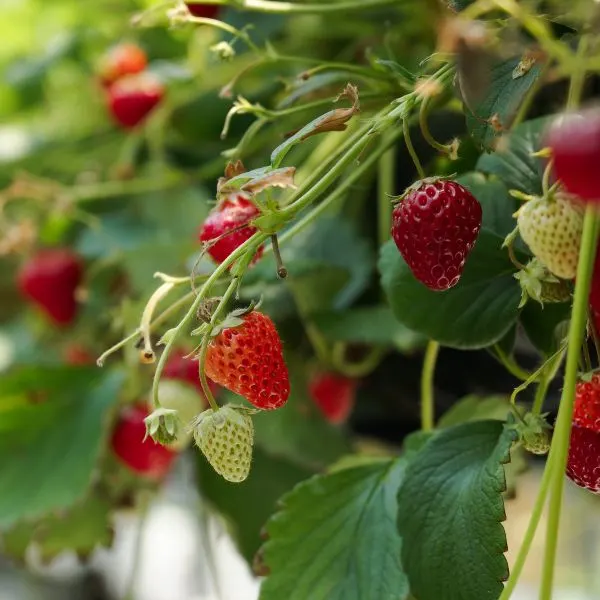
- Botanical name: Fragaria spp.
- Sun Requirements: Full sun to partial shade
- Soil Type: Well-drained, slightly acidic soil with a pH range of 5.5 to 6.5
Strawberries are a delicious and well-loved fruit that can be enjoyed in many ways. They belong to the rose family and are a perennial plant that uses runners, or stolons, to spread and reproduce. Their heart-shaped fruit is typically red, but there are also yellow and white varieties. Strawberries are a rich source of vitamin C and can be eaten raw or used to make jams, pies, and other desserts.
If you want to attract pollinators to your plants, adding wildflowers to your garden can be a great idea. Ideally, these wildflowers should be within 50 feet of your strawberry plants to increase the likelihood of pollinators visiting both.
Wildflowers come in many colors and offer nectar and pollen for pollinators, which makes them an attractive food source. In addition, they can attract helpful insect predators like birds, ladybugs, and beneficial wasps.
While any wildflower can work as a companion plant for fruits, vegetables, or herbs, it’s essential to note that this list is not exhaustive. Exploring various wildflower options can be beneficial in creating a diverse and healthy garden environment.
36. Sunflowers

- Botanical name: Helianthus annuus
- Sun Requirements: Full sun
- Soil Type: Well-drained soil of varying pH levels
Sunflowers are like sunshine on a stick, towering plants that are native to North America. Their bright yellow flowers can light up your garden and make you smile. These beauties belong to the aster family and can reach heights of up to 12 feet. Sunflowers are famous for their tasty seeds that can be eaten raw or roasted and for their oil, which is used in cooking and cosmetics.
Combining sunflowers and Bee Balm in your garden can have many benefits. First, both plants attract pollinators, creating a diverse ecosystem that supports beneficial insects. Second, sunflowers have deep roots that can improve soil quality and drainage, while Bee Balm has shallow roots, which can create a diverse root structure that further improves soil quality.
Moreover, Bee Balm is a natural pest repellent that can keep harmful bugs away from sunflowers while attracting predatory insects that provide natural pest control. Sunflowers can also provide shade and regulate moisture levels, creating a microclimate that promotes healthy growth for both plants. Finally, the tall, yellow sunflower flowers can be a beautiful complement to Bee Balm’s colorful blooms, creating a stunning garden.
By planting sunflowers and Bee Balm together, you can create a lovely and productive garden that supports pollinators, improves soil quality, and provides natural pest control. Companion planting is an eco-friendly and sustainable way to create a diverse and thriving garden.
37. Tall tickseed
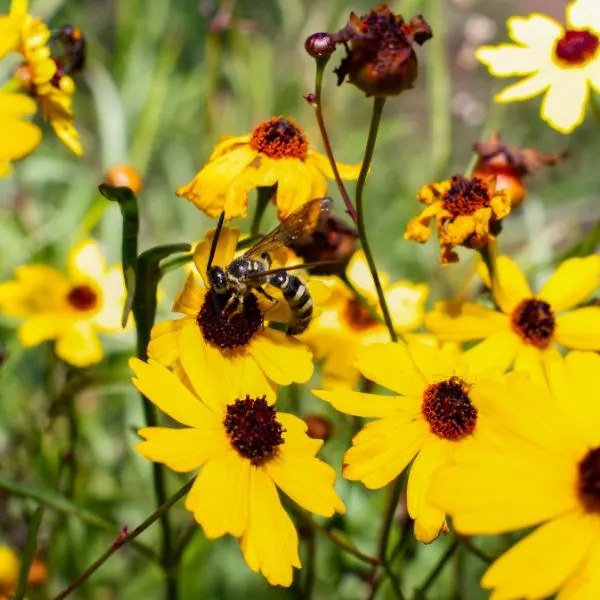
- Botanical name: Coreopsis tripteris
- Sun Requirements: Full sun
- Soil Type: Well-drained soil of varying pH levels
The tall tickseed is a North American wildflower with pretty yellow flowers that bloom in summer and fall. It’s loved by bees and butterflies and can grow up to 6 feet tall. Tall tickseed can be a great partner for Bee Balm in the garden because they both like well-drained soil and full sun. The yellow flowers of Tall tickseed can complement the pink or red blooms of Bee Balm and create a lovely visual contrast.
But be aware that Tall tickseed can be a bit of a spreader, so it’s important to be cautious when planting it in the garden. Consider using it as a backdrop for Bee Balm or planting it in a mixed border or wildflower garden. This way, it can add some height and texture without taking over the entire garden.
In general, Tall tickseed is a low-maintenance plant that can attract pollinators and add some interest to the garden. Just be mindful of its spreading tendencies and plant it with care.
38. Tomatoes
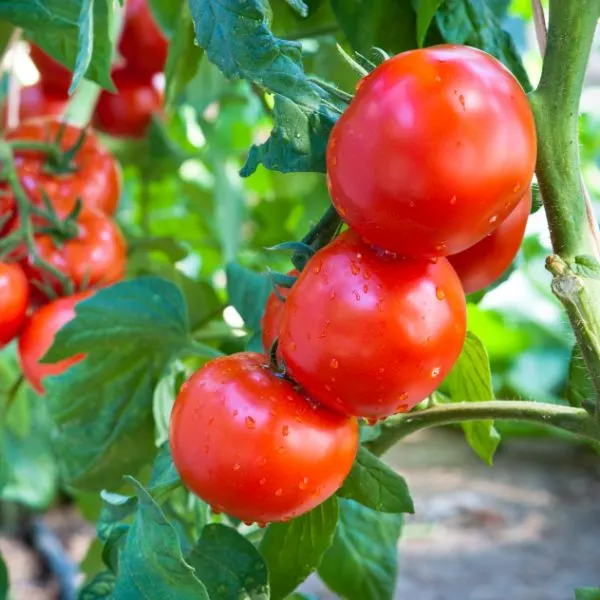
- Botanical name: Solanum lycopersicum
- Sun Requirements: At least 6 hours of direct sunlight per day
- Soil Type: Well-draining soil with pH between 6.0 to 6.8
Tomatoes are fruits, but we use them to like veggies in our cooking. They come in all sorts of colors and sizes, from classic red to yellow and green. Tomatoes are chock-full of vitamins A and C, and they make salads and sauces taste amazing.
Bee balm is a plant in the mint family that has a lot going for it. It’s great for attracting pollinators, and it can even improve the flavor of tomatoes! Bee balm is a great choice for companion planting with tomatoes since it can repel pests and lure them away from your tomato plants.
If you’re looking to grow bee balm with your tomatoes, there are plenty of different varieties to choose from. You’ll want to make sure you give each plant enough space to grow and flourish. Both tomatoes and bee balm love nutrient-rich soil, plenty of sunlight, and frequent watering.
By planting bee balm alongside your tomatoes, you can help them grow stronger and tastier while also keeping pests at bay and attracting pollinators. It’s a win-win situation for your garden! Just make sure to plant them in separate rows for easier maintenance.
39. Veronica
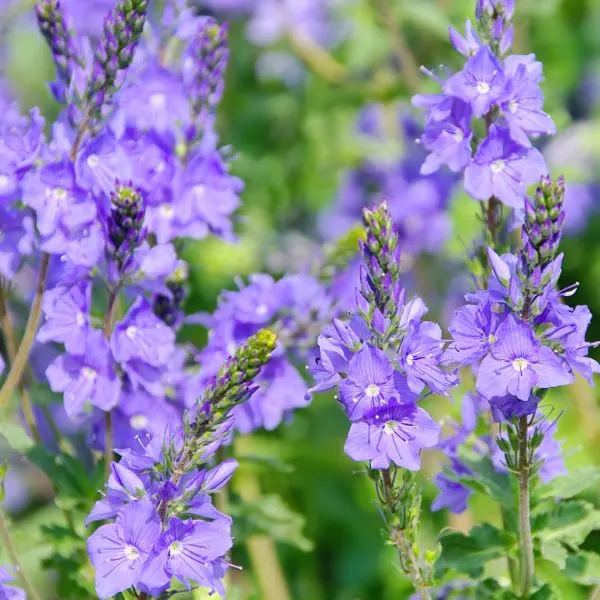
- Botanical name: Veronica spicata
- Sun Requirements: Full sun to partial shade
- Soil Type: well-draining soil with a pH between 5.8 to 6.8
Veronica, also known as speedwell, is a herbaceous perennial that spreads quickly and has small, blue, or purple flowers that bloom in the summer. It’s a member of the Plantaginaceae family and prefers full sun and well-drained soil, making it a popular choice for rock gardens and borders.
If you’re looking to add some diversity to your garden, consider planting Bee Balm alongside Veronica. These two plants make great companions, attracting pollinators like bees and butterflies while also offering a beautiful contrast of colors and heights.
But that’s not all – Veronica has some other tricks up its sleeve. Its roots release organic compounds that can help break up compacted soil and improve drainage, which is great news for your garden. Plus, Veronica can help keep pests at bay, which is particularly helpful for protecting Bee Balm.
By planting Veronica and Bee Balm together, you can create a visually stunning garden that is also functional and sustainable. It’s just one more way to make the most of companion planting and support a healthy ecosystem in your backyard.
40. Vervain
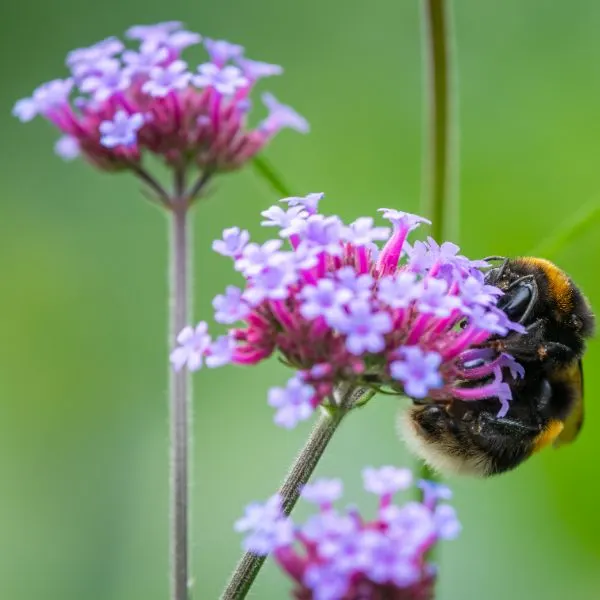
- Botanical name: Verbena officinalis
- Sun Requirements: Full sun to partial shade
- Soil Type: well-draining soil with a pH between 6.0 to 7.5
Hey there! Let me tell you a bit about Vervain, a really cool herbaceous plant that belongs to the Verbenaceae family. It’s got these gorgeous purple flowers that bloom during summer, and it’s often used in traditional medicine for its medicinal properties. But wait, there’s more! Vervain can also be grown in gardens just for show.
If you’re looking for a great companion plant for Bee Balm, look no further than Vervain (also known as verbena). These two plants have similar heights and colors that contrast beautifully. Plus, they both attract pollinators and repel pests. How cool is that?
But the benefits don’t stop there. Vervain has anti-inflammatory and calming properties, which can be enhanced if you plant it near Bee Balm. And did you know that Vervain is a deep-rooted plant that can help improve soil quality? By breaking up compacted soil and improving drainage, Vervain creates a healthier growing environment for both Bee Balm and itself.
And get this – planting Bee Balm around your Vervain can attract ladybugs, which can help control other garden pests. That’s right; these two plants work together to create a sustainable garden that supports pollinators, improves soil quality, and offers medicinal benefits.
So why not create a visually appealing garden bed or border with these complementary colors and textures? With companion planting, you can create a garden that’s both functional and attractive. All in all, the combination of Bee Balm and Vervain is a win-win situation for your garden!
41. Vines
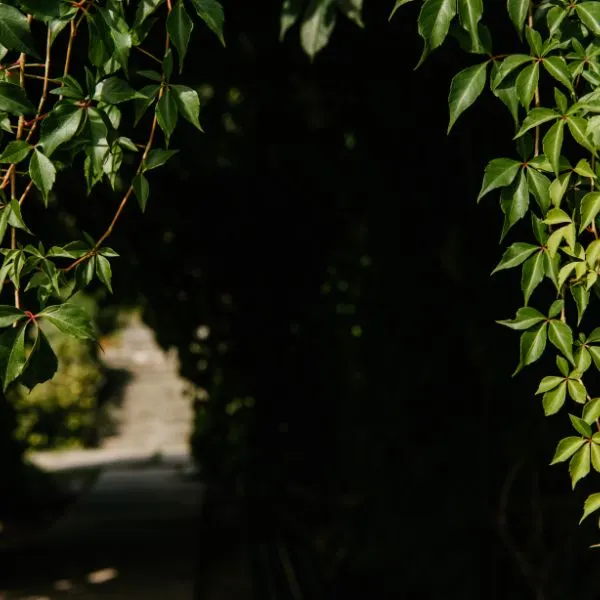
- Botanical name: Various
- Sun Requirements: Varies depending on the species
- Soil Type: Varies depending on the species
Vines are the perfect plants to add some height and interest to your garden. Whether you have a wall, trellis, or just some extra space, vines can be trained to climb and create a lush green screen. Some popular vine plants include grapes, ivy, wisteria, and climbing hydrangea.
But did you know that vines can also be great companion plants for Bee Balm? By planting different types of vines like clematis, morning glory, sweet pea, honeysuckle, and trumpet vine, you can attract beneficial insects like butterflies, bees, and other pollinators to your garden. These vines not only add visual interest and structure to the garden, but they also help control soil erosion.
Some of these vines, like clematis and morning glory, can also provide shade to Bee Balm in hot weather. It’s important to note, however, that some vines, like trumpet vine, can be aggressive and need to be contained to prevent them from taking over your garden.
By planting these vines alongside Bee Balm, you can create a beautiful and diverse garden that supports pollinators and enhances the growth and health of your plants. So go ahead and let your vines climb high, and your garden will thrive!
42. Violet
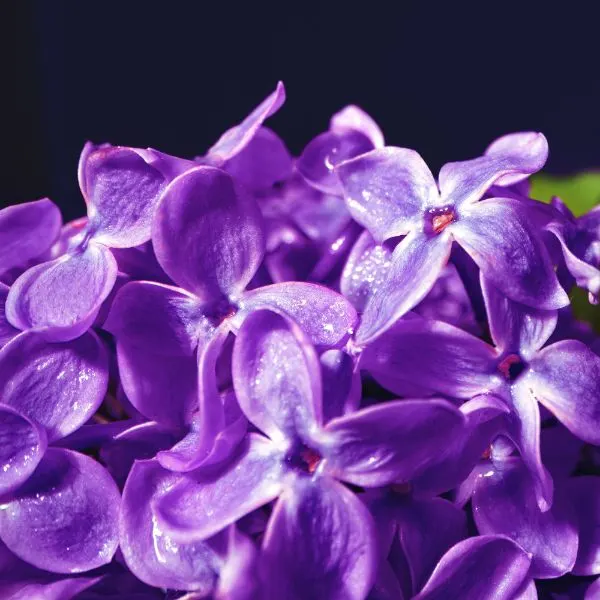
- Botanical name: Viola odorata
- Sun Requirements: Full sun to partial shade
- Soil Type: well-draining soil with a pH between 6.0 to 7.5
Violets are low-growing herbaceous plants that are known for their fragrant and delicate flowers. They are available in a variety of colors, including purple, blue, pink, and white. Violets prefer partial shade and moist soil.
Violet plants can be a great companion for Bee Balm. Planting violets near bee balm can attract pollinators and increase the chances of successful pollination. Moreover, violets can act as a natural ground cover, retaining moisture and preventing weed growth, which is beneficial for bee balm growth.
Violets have a low-growing habit that can provide shade to the soil around bee balm. This can keep the soil cool and prevent moisture loss, which is important for the growth and development of bee balm. In addition to their functional benefits, violets have small, delicate flowers that complement the bold, showy blooms of bee balm, creating an attractive garden space.
Overall, incorporating violets as a companion plant for bee balm offers several benefits, such as attracting pollinators, serving as a natural ground cover, providing shade, and enhancing aesthetics. Planting them together can be an excellent addition to any garden, providing a thriving ecosystem that supports pollinators, retains soil moisture, and enhances the beauty of the garden space.
43. Zucchini
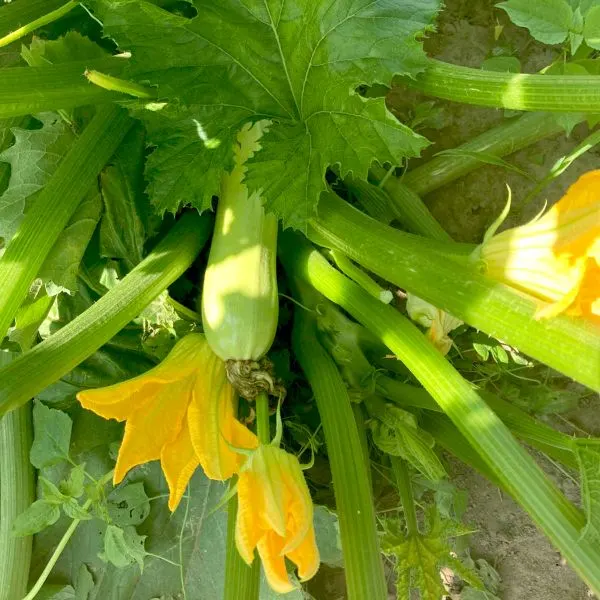
- Botanical name: Cucurbita pepo
- Sun Requirements: At least 6 hours of direct sunlight per day
- Soil Type: well-draining soil with a pH between 6.0 to 6.8
Zucchini, a popular summer squash from the Cucurbitaceae family, is a garden favorite because it’s simple to grow and yields an abundant harvest. It’s versatile, too, as it can be used in a range of dishes, from salads and stir-fries to pasta.
When it comes to companion planting, bee balm is a squash, pumpkin, and zucchini’s best friend. Bee balm’s leaves have an intense aroma that repels pests, while its flowers attract pollinators and helpful predators. It’s also low-maintenance, coming back year after year.
Although zucchini has a reputation for taking over the garden, it can coexist with bee balm. The bright yellow and orange flowers of squash, pumpkins, and zucchini complement bee balm’s fluffy red, purple, pink, and white blooms, creating a stunning contrast.
Having these plants in your garden not only adds visual appeal but also promotes a healthy ecosystem by supporting pollinators and repelling pests. So why not try companion planting zucchini with bee balm for a beautiful and healthy garden?
44. Yarrow

- Botanical name: Achillea millefolium
- Sun Requirements: Full sun to partial shade
- Soil Type: well-drained soil with average fertility
Yarrow is a fascinating herbaceous perennial that belongs to the Asteraceae family. In summer, flat-topped clusters of tiny flowers bloom, and it’s known for its medicinal properties. It’s also great for gardens because it attracts beneficial insects like butterflies and bees.
Companion planting yarrow with bee balm has many benefits. Yarrow attracts helpful insects such as ladybugs and lacewings that control pests. It also improves soil health and provides structural support to other plants around it. When planted with bee balm, yarrow can even enhance the citrusy scent of bee balm, making it even more alluring to pollinators.
By planting yarrow and bee balm together, you’re promoting the growth of natural predators of harmful pests, creating a healthy garden ecosystem. Yarrow’s ability to draw up nutrients from deep in the soil can improve soil health and support other plants’ growth. Its strong and fibrous root system can also provide structural support to bee balm and other plants.
Overall, growing yarrow and bee balm together is an easy gardening practice that offers many benefits. It attracts beneficial insects, enhances soil health, and improves the aroma of bee balm. Give it a try, and create a healthy and attractive garden ecosystem!
Bad Companion Plants for Bee Balms
1. Azaleas
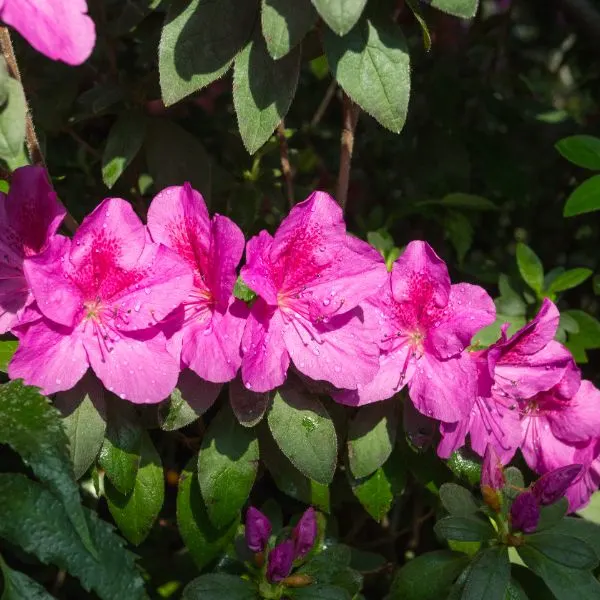
Azaleas prefer acidic soil and partial shade, while bee balm thrives in full sun and prefers neutral to slightly acidic soil. This means that it may be challenging to grow both plants in the same area without compromising the growing conditions for one or both plants.
While azaleas can attract some pollinators, they are not typically a top choice for bees and other beneficial insects. Additionally, azaleas do not have a reputation for improving soil quality or offering pest control benefits as companion plants.
While azaleas can be a beautiful addition to a garden, they may not offer significant benefits as a companion plant for bee balm. If you are looking to support pollinators or improve the growing conditions for your bee balm, it may be more effective to focus on other companion plants that are better suited to bee balm and have a stronger reputation for offering benefits such as increased pollination, pest control, or soil improvement.
2. Oregano
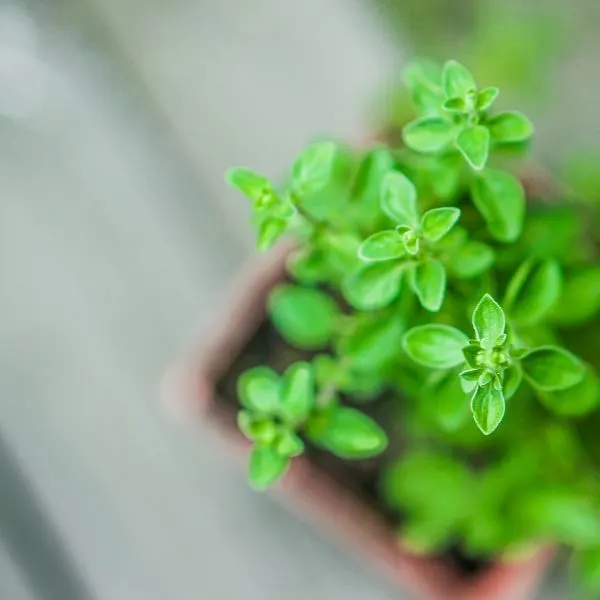
Oregano is a fast-growing and invasive plant that can spread quickly through underground rhizomes. This can cause it to compete with Bee Balm for resources such as nutrients, water, and sunlight. If left unchecked, oregano can easily overtake Bee Balm and other nearby plants in the garden.
Additionally, oregano has a strong aroma that can attract pests such as aphids and spider mites, which can potentially harm Bee Balm and other nearby plants. However, some gardeners believe that the strong aroma of oregano can also help to repel pests such as cabbage moths and cucumber beetles, which can be beneficial for the health of the garden.
3. Brassicas
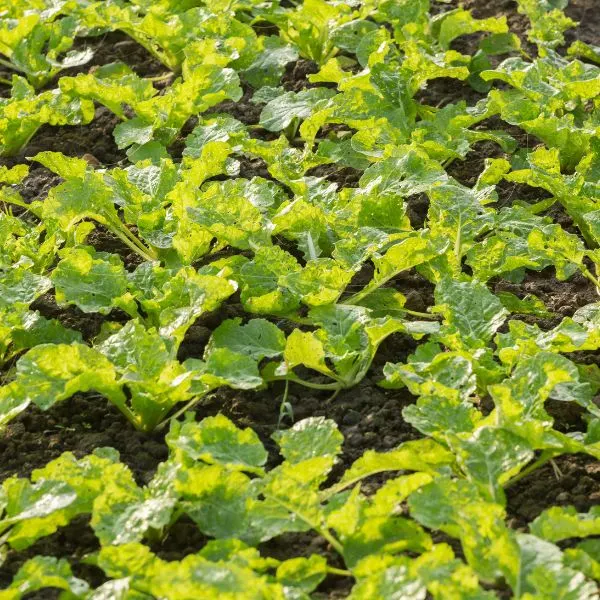
This is because brassicas release chemicals into the soil that can inhibit the growth of other plants, including Bee Balm. Additionally, brassicas can attract pests such as cabbage moths and flea beetles, which can potentially harm nearby plants, including Bee Balm. Furthermore, brassicas have different nutritional requirements than Bee Balm and may compete for soil nutrients, which can limit the growth and productivity of both plants.
When planning a garden with Bee Balm, it is important to choose companion plants that will promote the health and growth of Bee Balm rather than inhibit it. While planting brassicas and Bee Balm in close proximity is not necessarily a bad choice, it requires careful planning and management to ensure that both plants can thrive without negatively affecting each other. Gardeners who choose to plant brassicas and Bee Balm together should be prepared to monitor the health of both plants closely and address any issues that may arise in a timely manner. Additionally, they may consider adding compost or fertilizer to help both plants grow and thrive.
4. Mint
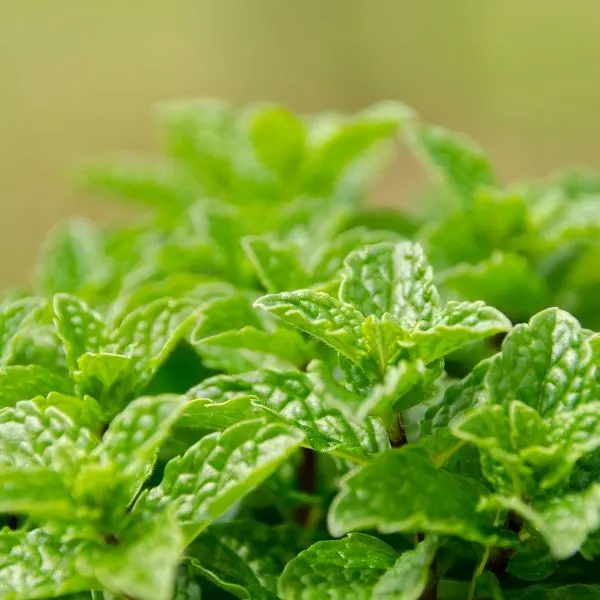
Mint is not considered a good companion for Bee Balm because it is also a fast-growing and invasive plant that can quickly spread and take over an area. Mint can compete with Bee Balm for resources such as water, nutrients, and sunlight, which can potentially harm the growth and health of Bee Balm. Additionally, mint has a strong aroma that can attract pests such as aphids and spider mites, which can potentially harm nearby plants, including Bee Balm. Furthermore, both plants belong to the same family, Lamiaceae, which means that they have similar growth habits and nutritional requirements, making them more likely to compete with each other for resources.
Overall, planting Bee Balm and mint together is not necessarily a bad choice, but it requires careful planning and management to ensure that both plants can thrive without negatively affecting each other. Gardeners who choose to plant Bee Balm and mint together should be prepared to regularly prune and manage the mint to prevent it from spreading too aggressively and to monitor the health of both plants to address any issues that may arise in a timely manner.
Common questions about Bee Balm
Do you need to deadhead bee balm?
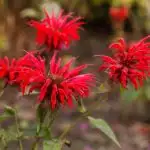
Bee balm (Monarda) begins to bloom in July and will continue to bloom throughout late summer. To encourage bountiful clusters of flowers, you will want to deadhead the plant throughout its entire bloom time. As the flowers begin to wilt and fade, cut just above the next flower bud.
Will bee balm choke out other plants?

If other plants in your garden are being infringed upon by bee balm, and their root systems and rhizomes are entangled, you may be left with no other choice but to dig both plants up completely to untangle them.
How do you make bee balm bushier?
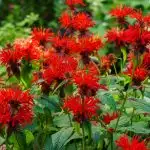
If you want a bushier plant, pinch off the stem tips as new growth appears in the early spring. In late fall, cut the bee balm down to just a few inches (5 to 10 cm.) tall. In cold areas, it may die completely to the ground during the winter but will reappear in the spring.
Will bee balm reseed itself?

Like other herbs in the mint family, bee balm is considered to be a bit invasive. It will easily self-sow and also spread by underground rhizomes. If you give it plenty of room in your garden, you will be rewarded with a beautiful display of bright blooms each year.
Does bee balm bloom the first year planted?

Keep in mind that Bee Balm started from seed and will not bloom the first year. So you should not worry if you do not see any blossoms. Avoid harvesting your Bee Balm so that it can become well-established, and you should see plenty of bright, colorful blooms in the second season.
How much space does bee balm need?

Space bee balm plants 18 to 24 inches apart in an area with full sun and fertile, well-drained soil with a pH of 6.0 to 6.7. Improve native soil by mixing in several inches of aged compost or other rich organic matter.
How often should you water bee balm?
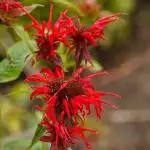
Bee balms are like an even supply of moisture during the growing season. For best performance, water bee balms every 7 to 10 days during dry periods. When watering, soak the soil to a depth of 6 to 8 inches. Apply mulch around plants to conserve soil moisture and reduce the frequency of watering.
In Summary
Bee balm, also known as Monarda, is a herbaceous perennial that is native to North America, and in this article, we have been able to look into Forty-four (44) Good companion plants for Bee balm and Four (4) Bad companion plants for Bee balm, also the reason why they are classified to be that.
One thing to keep in mind is that bee balm can be invasive in some regions, so keep an eye on its growth and trim it back if needed. Also, powdery mildew can be an issue, especially in humid climates. To prevent it, ensure good air circulation around the plant and water it at the base, avoiding wetting the leaves.
Lastly, if you’re allergic to bees, you might want to think twice before planting bee balm. It’s a real favorite among bees and other pollinators. But for everyone else, it’s a fantastic addition to any garden and great for attracting beneficial insects.
More companion plants
